Don’t let confusing jargon and mismatched connections ruin your listening experience. Here’s a deep dive into headphone jacks and plugs.
Wired music listening should be straightforward: insert the headphone plug into the jack, and you’re good to go.
However, that’s not always the case. Without knowing how jacks and plugs work, you may experience a mismatch, introducing some sound quality issues. Unfortunately, this topic is full of unfamiliar terms, numbers, and complex diagrams that anyone can easily get lost in.
Overcoming this technical concept should be easy with a comprehensive cheat sheet. For this reason, we’ve created a guide to help you learn how jacks and plugs work and how they relate to your headphones’ performance. Read on!
In This Article
- Headphone Jack vs. Plug: What’s the Difference?
- How Headphone Jacks and Plugs Work
- How to Identify Headphone Plug Conductors
- Different Plug Conductor Configurations
- Different Sizes of Headphone Jacks and Plugs
- How the Headphone Jack and Plug Affect Sound Quality
- Other Headphone Jacks and Plugs Factors That Affect Sound Quality
- Let’s Practice Our New Skill
Headphone Jack vs. Plug: What’s the Difference?
Simply put, the “headphone jack” is the port into which you plug your headphones. Sometimes, this is also called a phone jack, an audio jack, or AUX input.
The “plug,” on the other hand, is the part at the end of your headphones’ cable that you stick into the jack.
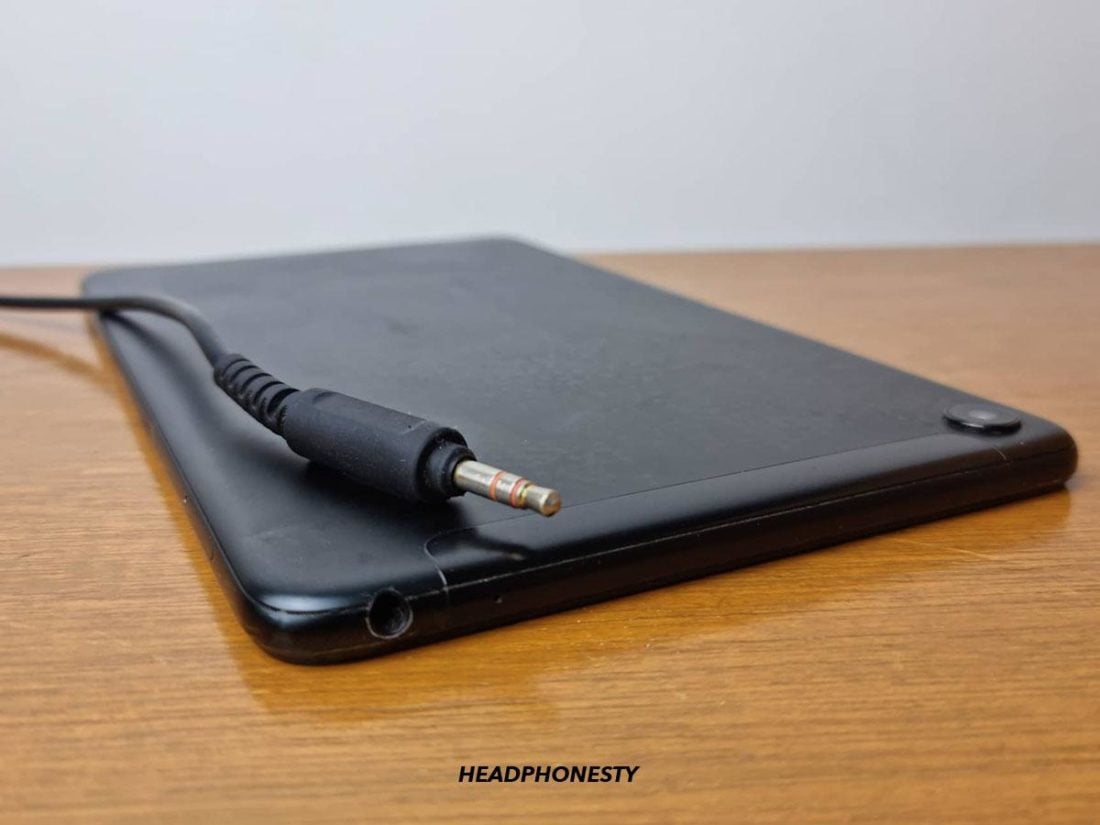
Jacks and plugs are assigned genders, as per the Association of Electrical & Mechanical Trades. The “jack” is the “female connector,” while the “plug” is the “male connector.”
Unfortunately, the audio industry has yet to unite on the distinctions between plugs and jacks. As such, you’ll often find “plug” and “jack” mistakenly used interchangeably.
In more technical terms, the headphone jack and plug are electrical connectors. Both transmit analog audio signals between your headphones and an audio source.
How Headphone Jacks and Plugs Work
The metal pin of the headphone plug has conductors that help transmit audio signals. These conductors come in a gold, nickel, or brass finish, offering varying durability levels.
In contrast, the jack is a hollow barrel lined with conductors.
The conductors in the plug and jack are assigned specific signals, so it’s paramount that they match.
The number of wires inside your headphones’ cable matches the number of conductors on their plug. So, two wires have two conductors, three wires have three conductors, and so on.
This, in turn, corresponds to the conductors in the jack. When you insert a plug into a compatible jack, all conductors should line up perfectly, allowing the audio signal to pass through.
What are headphone plug conductors and why do they matter?
Conductors are the contact points between the plug and the jack, which close the circuit. All headphone plugs, regardless of their size, have conductors. Some plugs have only two conductors, while others have as many as five.
As mentioned in the previous section, compatibility is a significant factor for conductors.
If a mismatch occurs between the conductors on the plug and jack, they won’t line up and make complete contact. This incompatibility can then cause some signals to override others, thus interfering with specific functions of your headphones. In other cases, mismatches can also trigger an electrical short.
How to Identify Headphone Plug Conductors
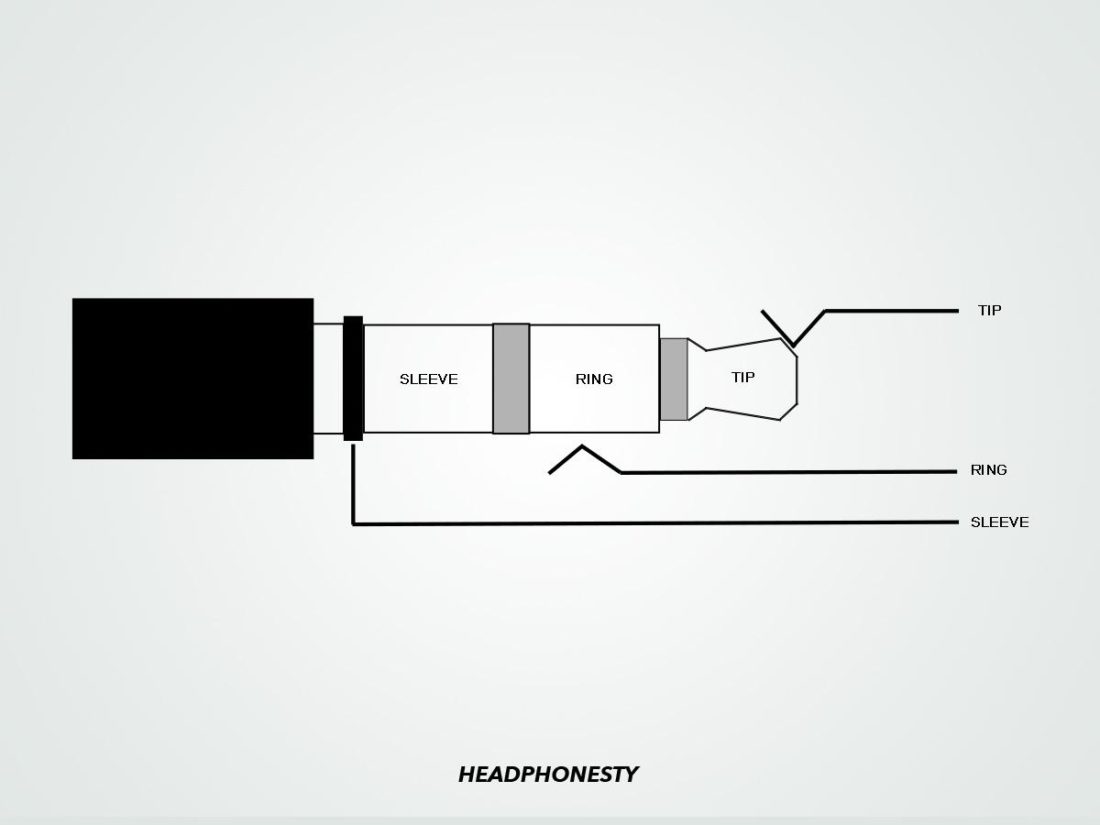
The different headphone plug conductors have specific names, which are:
- Tip (T)
- Ring (R)
- Sleeve (S)
All headphone plugs have a tip and sleeve. What differentiates each plug is the number of rings. For instance, plugs with one ring are 3-conductor plugs, while those with no rings are 2-conductor plugs.
The terminology for these different combinations is as follows:
- TS (Tip-Sleeve): 2 conductors or poles
- TRS (Tip-Ring-Sleeve): 3 conductors or poles
- TRRS (Tip-Ring-Ring-Sleeve): 4 conductors or poles
- TRRRS (Tip-Ring-Ring-Ring-Sleeve): 5 conductors or poles
Different Plug Conductor Configurations
As previously mentioned, the number of conductors indicates how many wires are inside the headphones’ cable. Each of those wires is connected to a specific conductor and carries a different signal.
So, which signals go to which conductor?
Generally speaking, the wiring schemes for conductors usually look something like this:
- Tip: Signal wire or left channel audio signal
- Ring: Right or left channel audio signal, common return and ground wire, mic audio
- Sleeve: Common return and ground wire, mic audio
However, manufacturers can choose to configure jacks and plugs in various ways.
But one thing remains constant regardless of the configuration: both must be complementary.
That said, it’s a good idea to familiarize yourself with plug conductor configurations to avoid functional errors in your audio devices. To help with this, we’ll break down each format and explain its uses:
- 2-conductor plug (TS)
- 3-conductor plug (TRS)
- 4-conductor plug (TRRS)
- 5-conductor plug (TRRRS)
- Lightning plugs
- USB plugs
2-conductor plug (TS)
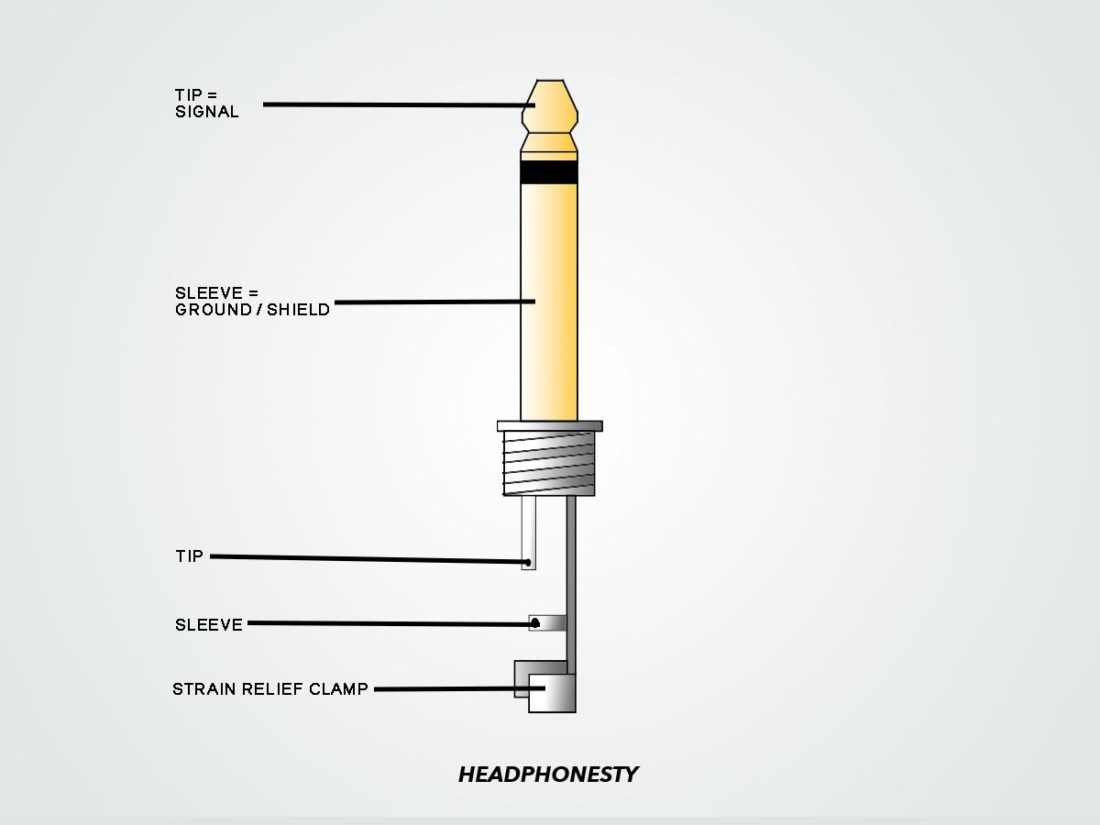
Available Connectors: Tip, sleeve, and one insulating band
Connectors’ Connection:
| Pin | Function |
|---|---|
| 1 | Ground |
| 2 | Signal |
A TS configuration is relatively straightforward. The tip connector carries the audio signal, while the sleeve acts as a return path and ground.
However, since the ground is a reference point for the signal, it can pick up interference noises like an antenna. The longer the cable, the higher chance it’ll pick up more noise.
Common Usage: You can find TS connectors mainly with guitars, instruments, and applications that do not require a long cable connection.
3-conductor plug (TRS)
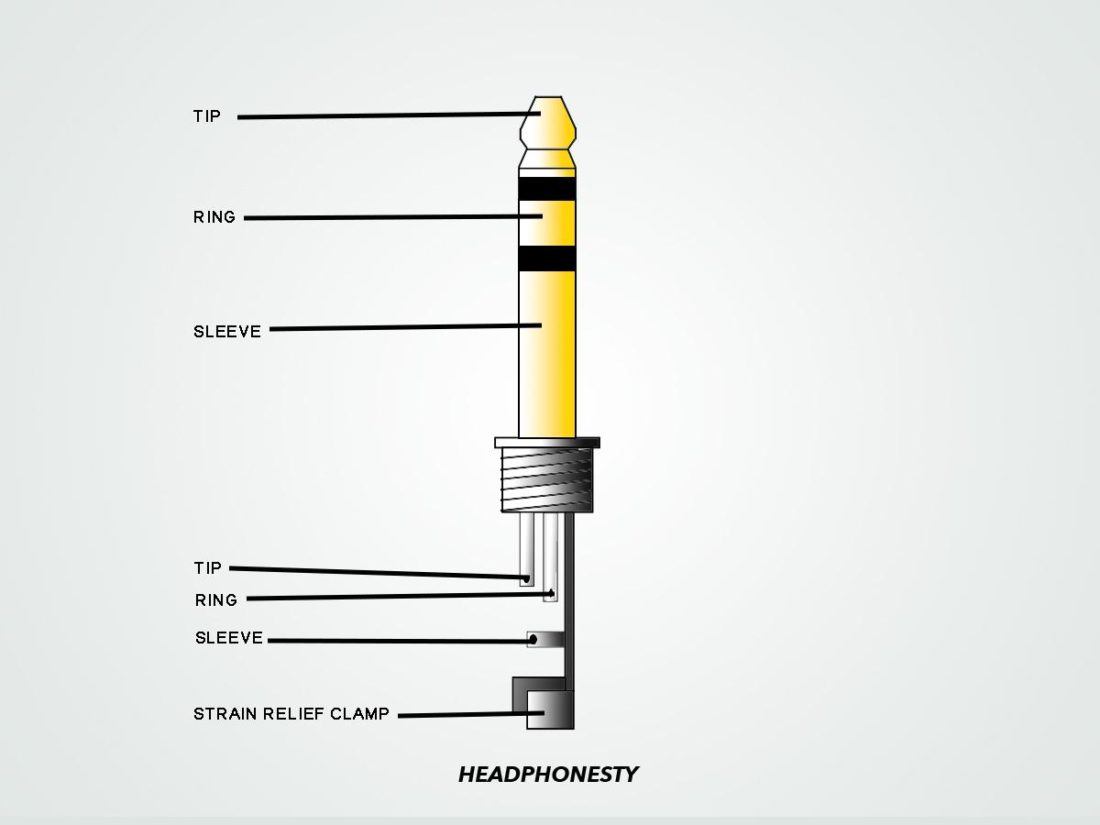
Available Connectors: Tip, sleeve, and one ring connector with two insulating bands
Connectors’ Connection:
| Pin | Unbalanced Mono | Balanced Mono | Unbalanced Stereo |
|---|---|---|---|
| 1 | Ground | Ground | Ground |
| 2 | Optional (mic, etc.) | Signal - (Cold) | Right audio channel |
| 3 | Signal | Signal + (Hot) | Left audio channel |
Adding a ring conductor (R) opens up different possibilities, such as support for balanced mono signals and unbalanced stereo signals.
As the “Unbalanced Mono” column shows, the engineer can make the additional conductor carry a microphone signal instead. In cases like these, wherein the audio is unbalanced, we can refer to this as a single-ended plug.
Common Usage: These are the most common jack connectors; you’ll often see them on the end of most stock headphone cables.
4-conductor plug (TRRS)
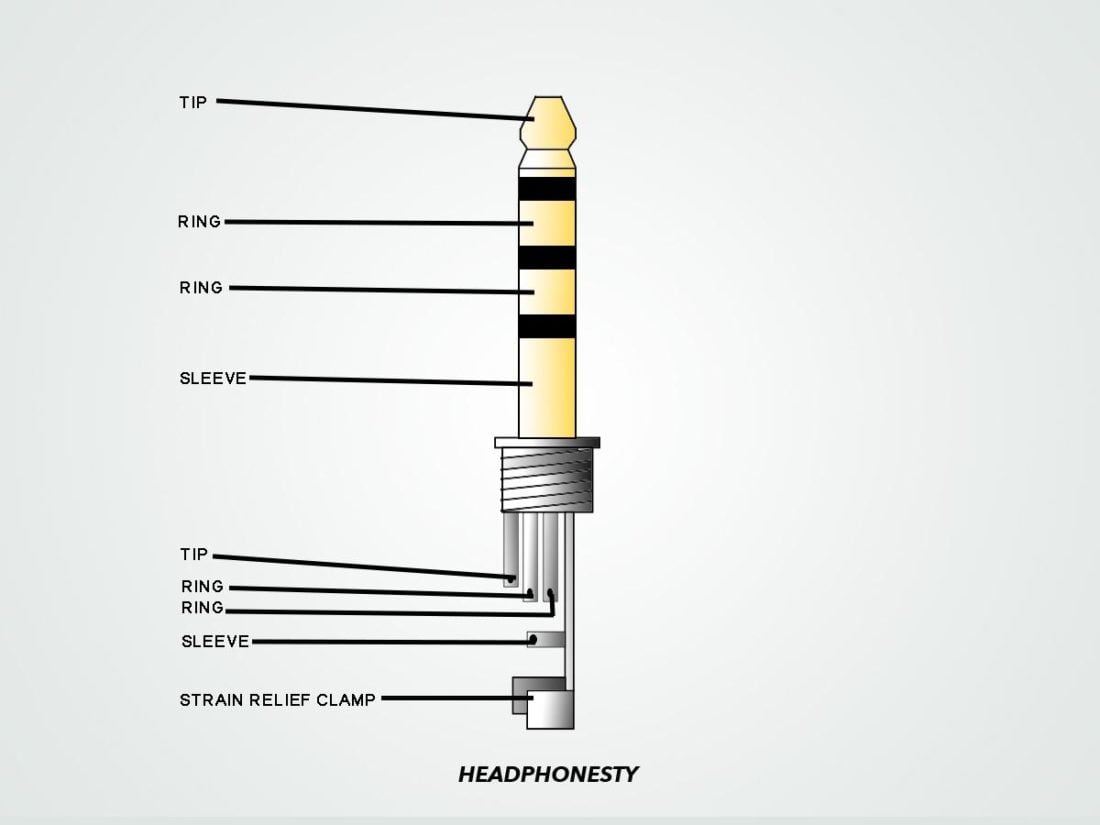
Available Connectors: Tip, sleeve, and two ring connectors with three insulating bands.
Connectors’ Connection:
| Pin | Function |
|---|---|
| 1 | Microphone |
| 2 | Ground |
| 3 | Right audio channel |
| 4 | Left audio channel |
Aside from transmitting stereo audio signals, the TRRS plug also has a dedicated conductor for a microphone. However, its position in the line-up varies depending on whether it follows the Cellular Telecommunications and Internet Association (CTIA) or Open Mobile Terminal Platform (OMTP) standards.
As such, this connection configuration is also called the CTIA or OMTP TRRS jack connector format.
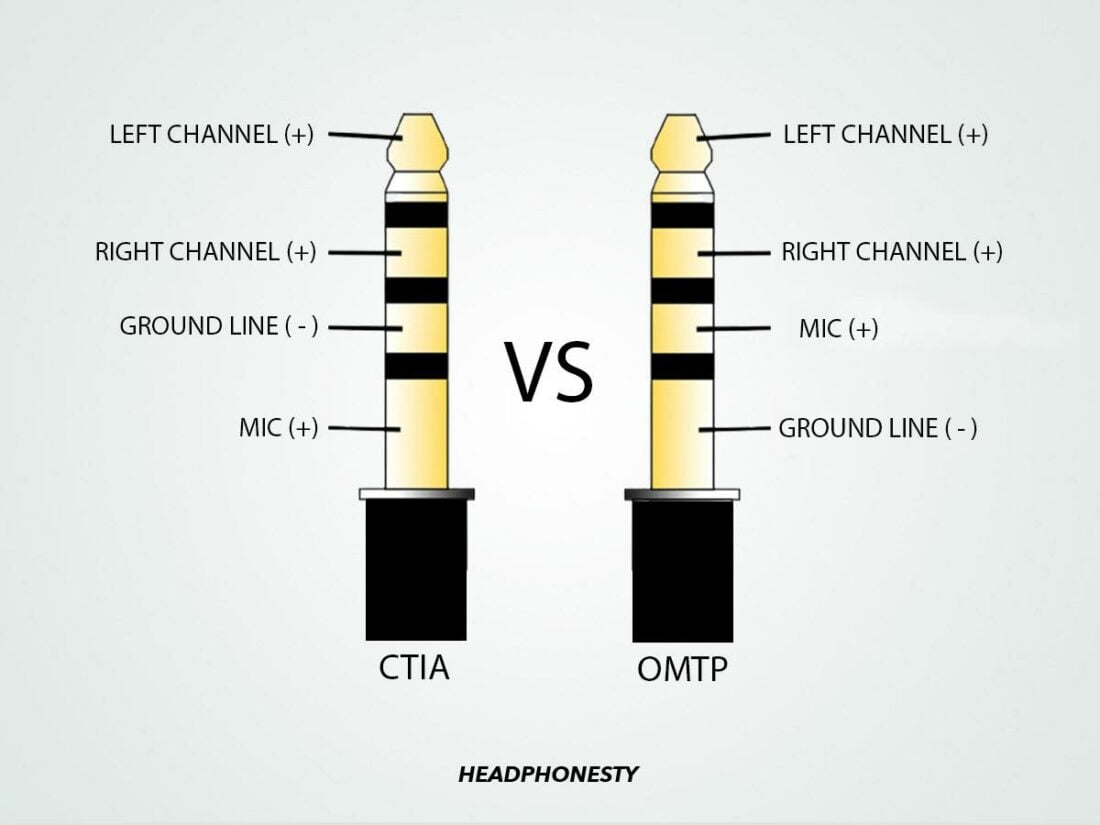
For instance, the CTIA format transmits left and right audio channels through the tip and first ring. The second ring then acts as the ground, while the sleeve handles the mic signal. This format is common on newer smartphones, mobile devices, and gaming consoles.
Like CTIA, the OMTP format sends audio signals through the tip and first ring. However, the conductors for the ground and mic are flipped around. This format is more prevalent among older phone models from Nokia, Motorola, Sony Ericsson, and China-marketed products.
Common Usage: New and old smartphones, tablets, gaming consoles, and some laptops.
5-conductor plug (TRRRS)
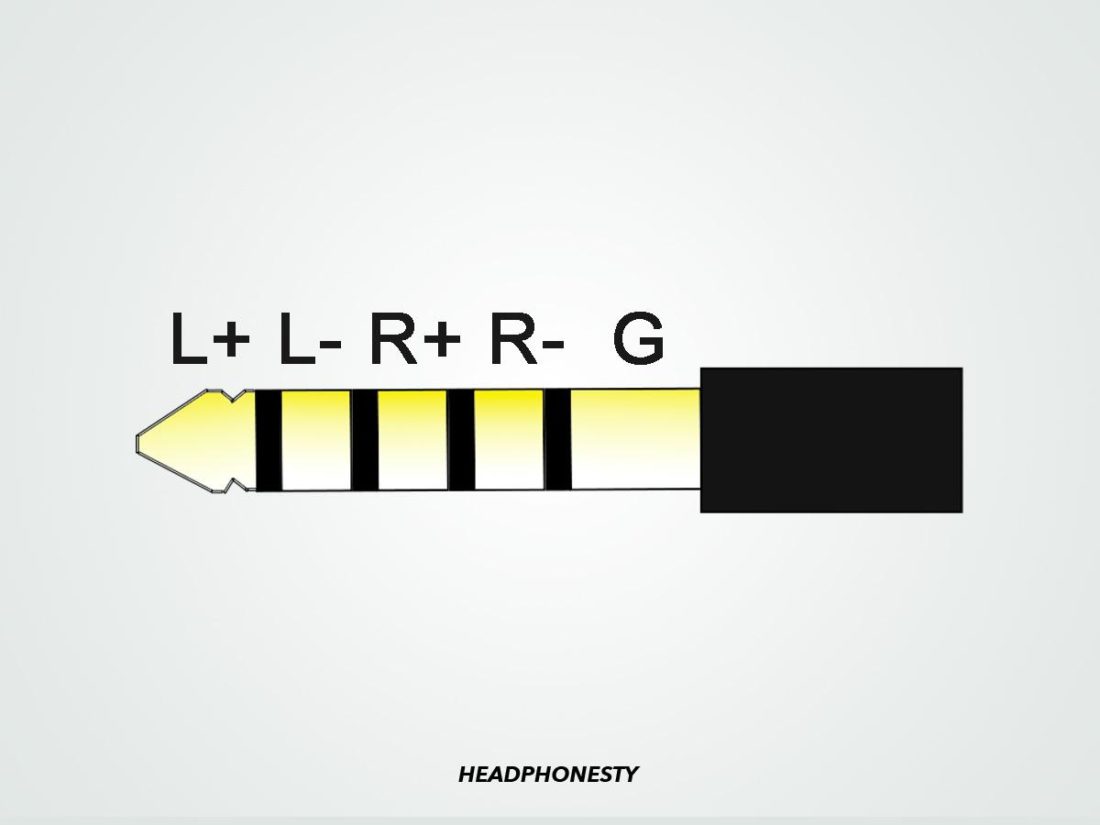
Available Connectors: Tip, sleeve, and three-ring connectors with four insulating bands
Connectors’ Connection:
| Pin | Function |
|---|---|
| 1 | Ground |
| 2 | Right audio channel (-) |
| 3 | Right audio channel (+) |
| 4 | Left audio channel (-) |
| 5 | Left audio channel (+) |
TRRRS connectors have five conductors that support balanced stereo signals.
XLR connectors (3 pins, 4 pins, and 5 pins) are similar in that regard. However, they only have pins instead of tips, rings, and sleeves.
With this setup, each audio channel gets a dedicated conductor, allowing it to transmit clearer signals. So, it’s no surprise that when balanced headphone connections grew in popularity, the XLR became the go-to solution.
Today, 3-pin XLRs are the standard balanced connector in the professional audio market.
As for mobile devices, the additional ring on the TRRRS plug ensures compatibility with newer products that feature multiple microphones or other audio functions like active noise cancellation.
Common Usage: You’ll find TRRRS plugs often used in professional sound and music production settings.
Lightning plugs
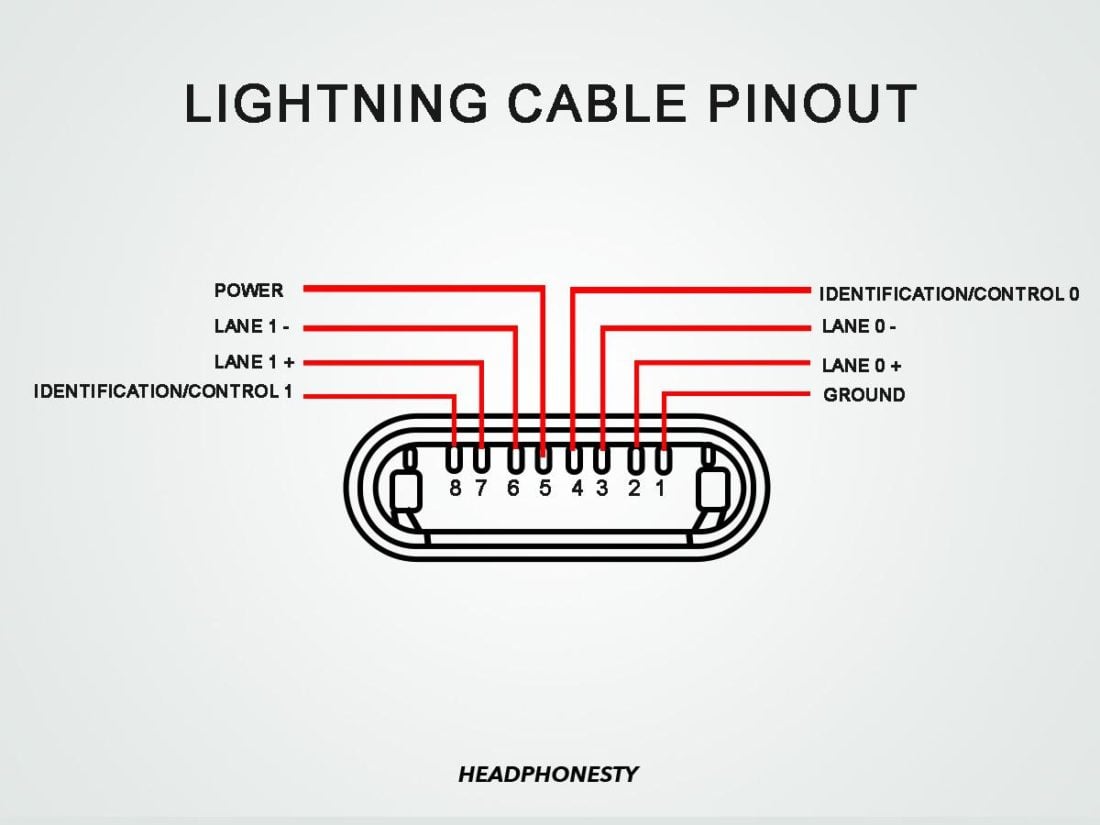
Available Connectors: Eight pins
Connectors’ Connection:
| Pin | Function |
|---|---|
| 1 | Ground |
| 2 | Lane 0 positive |
| 3 | Lane 0 negative |
| 4 | Identification/control 0 |
| 5 | Power |
| 6 | Lane 1 negative |
| 7 | Lane 1 positive |
| 8 | Identification/control 1 |
Smartphone companies have been letting go of the trusty headphone jack in favor of thinner smartphone builds. In its place, you have digital connectors like Lightning and USB (A and C).
Lightning, Apple’s proprietary connector, features eight conductor pins and four processor chips that help route signals to where they need to go.
When it comes to audio, this is transmitted as digital signals, then converted into analog signals by the DAC (digital-to-analog converter) in your headphones.
Aside from music, Lightning also carries digital data (video, photos, etc.) and supplies power to charge other Apple devices.
Common Usage: You can find Lightning connectors on various Apple products, from Macbooks to EarPods.
USB plugs
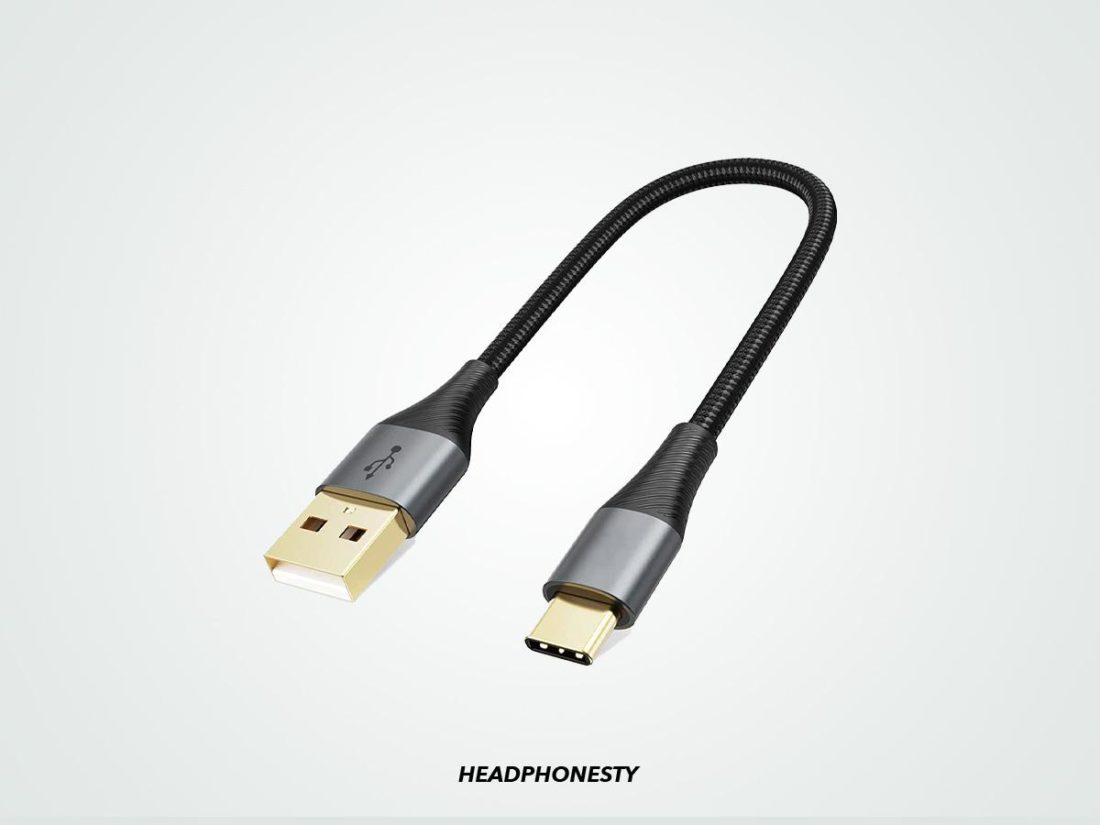
Available Connectors: Twenty-four pins (USB-C) and four pins (USB-A)
Connectors’ Connection:
For USB-C:
| Pin (USB-C Plug) | Function |
|---|---|
| A1, B12B1, A12 | Ground |
| A4, B9B4, A9 | Power (VBUS) |
| B5 | Power (VCONN), for powered cables |
| A5 | Configuration channel |
| A6 | Unshielded twisted pair, positive |
| A7 | Unshielded twisted pair, negative |
| A8 | Sideband use A |
| B8 | Sideband use B |
| A2 | Shielded differential pair #1, positive |
| A3 | Shielded differential pair #1, negative |
| B11 | Shielded differential pair #2, positive |
| B10 | Shielded differential pair #2, negative |
| B2 | Shielded differential pair #3, positive |
| B3 | Shielded differential pair #3, negative |
| A11 | Shielded differential pair #4, positive |
| A10 | Shielded differential pair #4, negative |
For USB-A:
| Pin (USB-A plug) | Function |
|---|---|
| 1 | Power (VBUS) |
| 2 | Data - |
| 3 | Data + |
| 4 | Ground |
USB plugs (A and C) are standard digital connectors for headphones. Both, however, are vastly different in terms of size and configuration.
The larger USB-A plugs have four conductor pins, whereas the smaller Type-C plugs have twelve.
Like Lightning connectors, USB connectors transmit digital audio signals, transfer digital data, and supply power. But, the USB-C functions at a much higher and faster rate, thanks to a heftier power capacity of 100 watts.
Common Usage: Aside from headphones, you’ll also find USB A and C connectors on computer peripherals such as printers, smart TVs, scanners, keyboards, external hard drives, and more.
Different Sizes of Headphone Jacks and Plugs
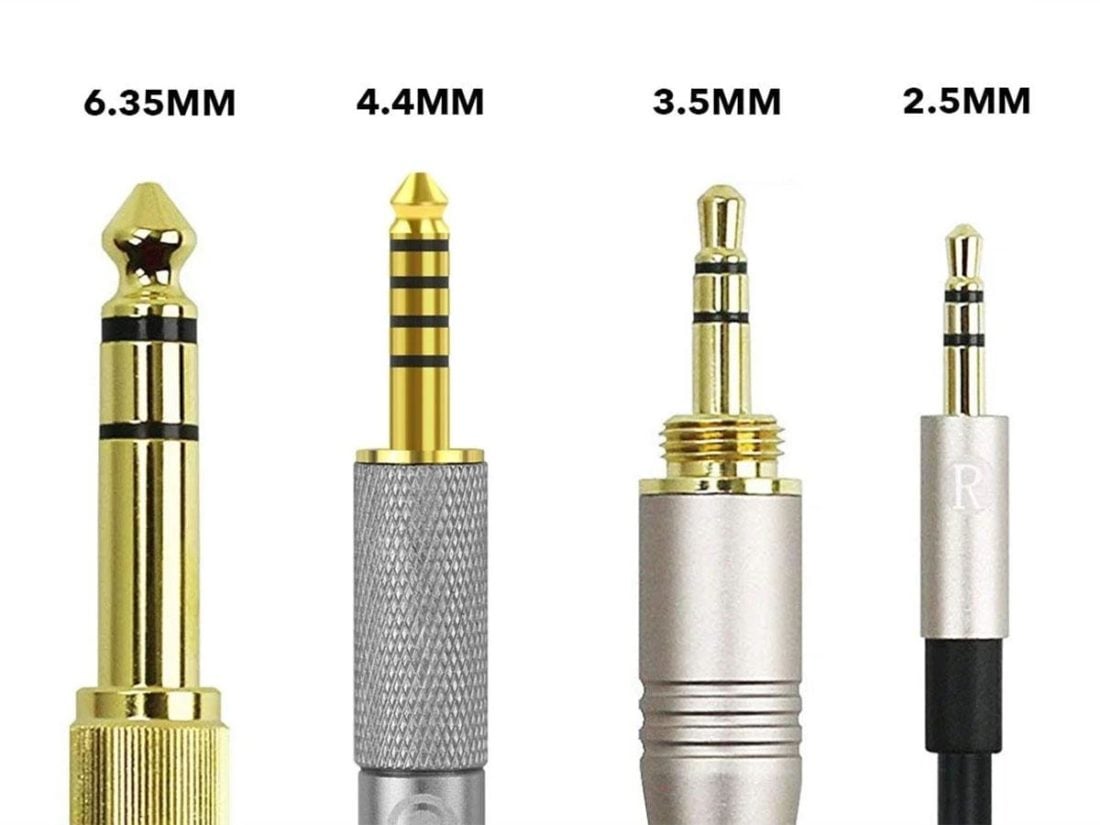
Headphone jacks and plugs come in different sizes, and it’s essential to have a basic understanding of these differences to ensure compatibility between your audio devices.
Common size configurations for jacks and plugs are 3.5mm, 2.5mm, and 6.35mm. The 3.5mm jack, in particular, is practically universal for headphones and audio gear and thus is considered the standard headphone jack size.
That said, here’s a closer look at the different headphone jack sizes and their functions:
- 3.5mm (1/8″) headphone jack and plug
- 2.5mm (3/32″) headphone jack and plug
- 6.35mm (1/4″) headphone jack and plug
3.5mm (1/8″) headphone jack and plug
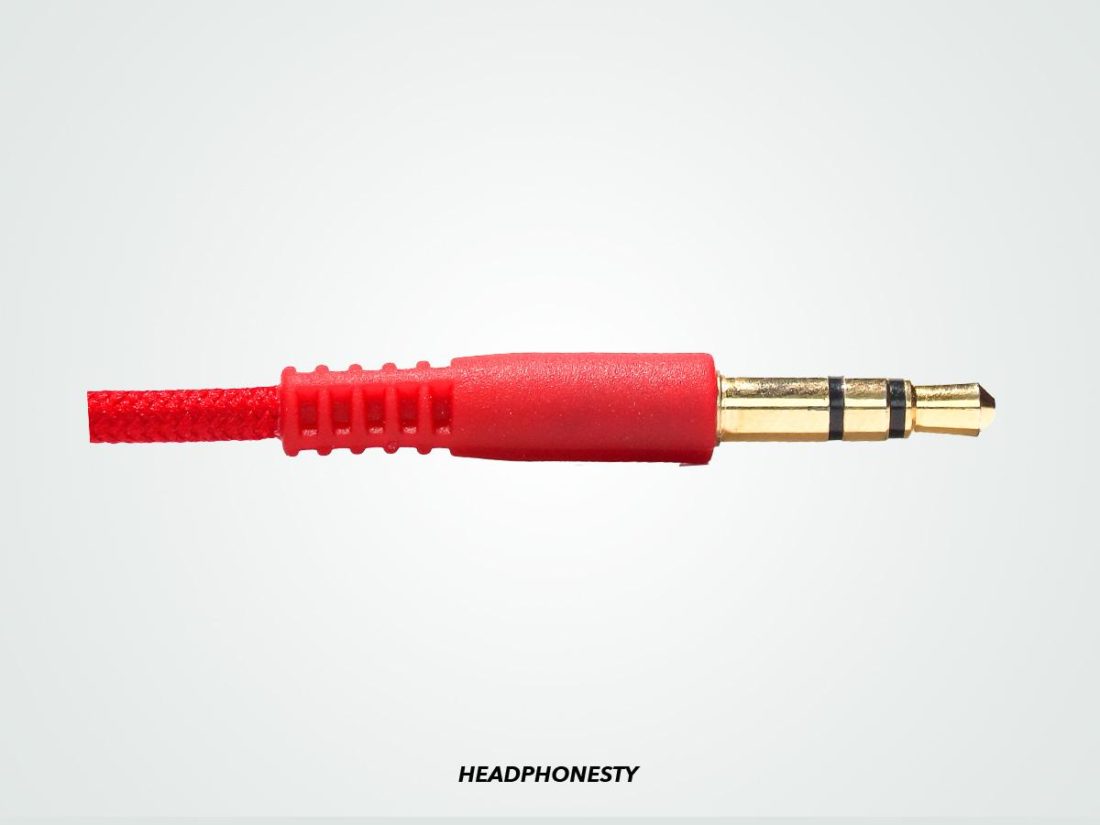
Otherwise known as a “miniature” or “mini” connector, the 3.5mm plug often comes in TS, TRS, or TRRS configurations. It readily outputs mono and stereo audio, plus video. You can find this type of connector on a wide range of headphones, mobile devices, portable media players, video recorders, etc.
If you need a 3.5mm cable, here are some good ones:
| Name | Size | Conductors |
|---|---|---|
| AmazonBasics 3.5mm Male to Male Stereo Audio Aux Cable | 3.5mm to 3.5mm | TRS |
| Zeskit Aux Audio Cable | 3.5mm to 3.5mm | TRRS |
| Kingtop Combo Audio Adapter Cable | 3.5mm male to 3.5mm female | TRRS |
2.5mm (3/32″) headphone jack and plug
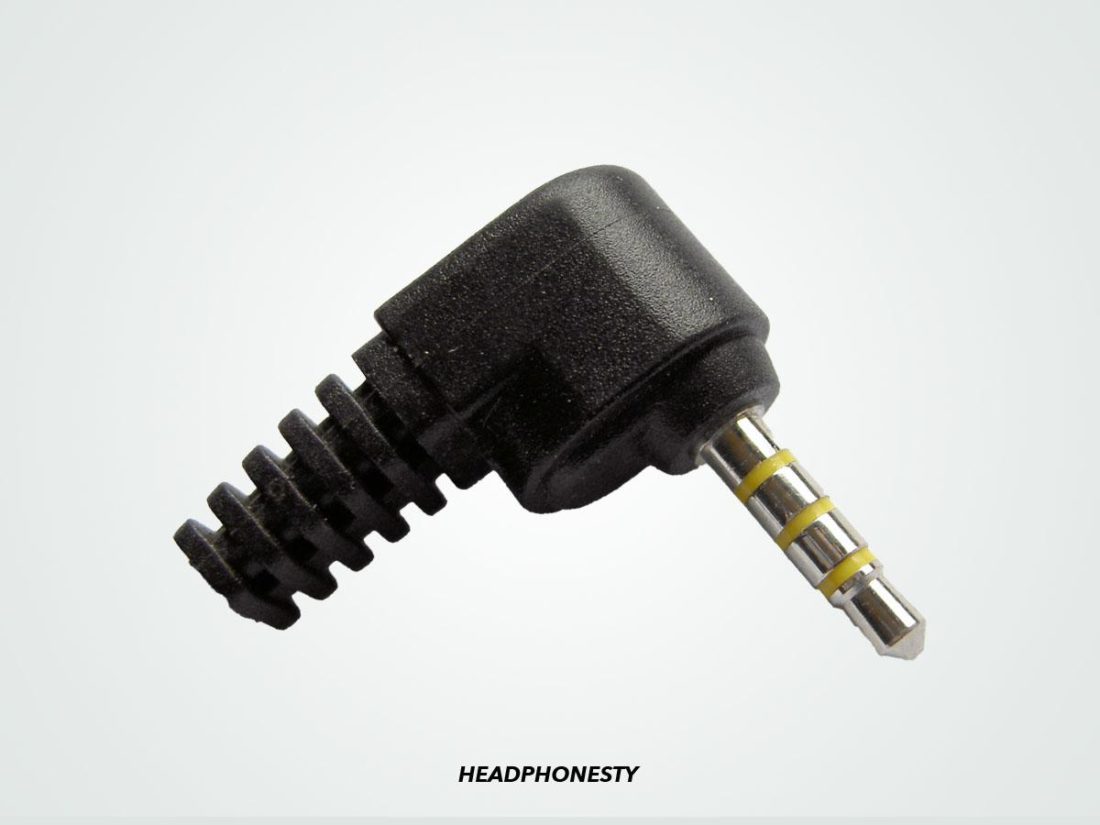
Sometimes called a “sub-miniature” or “sub-mini,” the 2.5mm plug is a smaller version of the 3.5mm plug. Functionally, both are the same. The 2.5mm plug also comes in TRS and TRRS configurations and outputs mono and stereo audio.
The difference is that these plugs and jacks are primarily found on headsets with microphones, two-way radios, TTY devices, and landline phones.
If you’re looking for a 3.5mm to 2.5mm cable, here are a couple to consider:
| Name | Size | Conductors |
|---|---|---|
| NewFantasia Replacement Cable with Remote and Mic | 2.5mm to 3.5mm | TRS |
| NewFantasia HiFi Cable Balanced Male | 2.5mm to 2.5mm | TRRS |
6.35mm (1/4″) headphone jack and plug
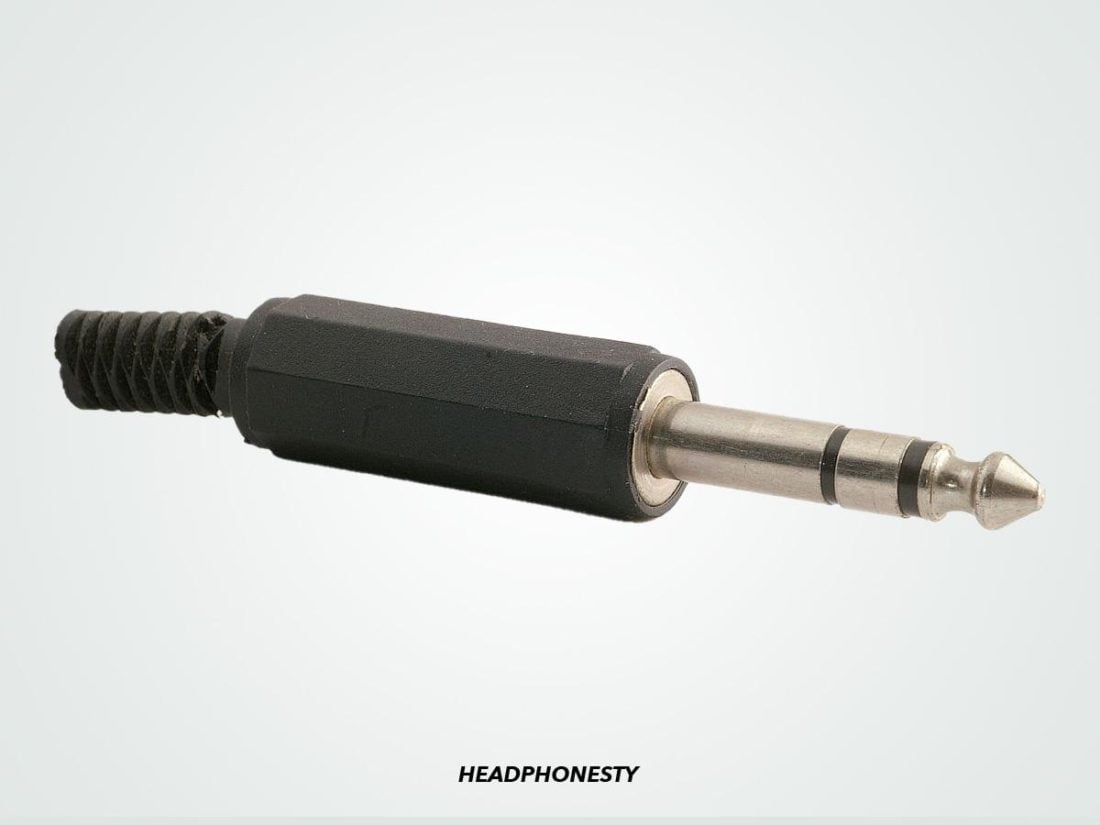
The 6.35mm plug, or ¼-inch connector, is this list’s largest and oldest connector. They were traditionally used as old-school telephone connectors and come in TS or TRS configurations.
Today, people use 6.35mm connectors mainly with professional audio equipment such as amplifiers, mixing consoles, audio interfaces, and musical instruments.
These are some examples of 6.35mm connectors:
| Name | Size | Conductors |
|---|---|---|
| UGREEN Stereo Audio Adapter | 6.35mm Male to 3.5mm Female | TRS |
| UGREEN Stereo Audio Cable | 6.35mm to 3.5mm | TRS |
How the Headphone Jack and Plug Affect Sound Quality
Since headphone plugs and jacks are responsible for transmitting audio signals, they can:
- directly affect audio signals
- indirectly affect the overall quality of sound
- tell us what the cable is capable or incapable of doing (mic, stereo support, etc.).
Before we delve into how this happens, let’s first tackle two basic concepts regarding transmitted signals between headphones and audio sources.
Mono vs. stereo signal
There are two types of signals transmitted from an audio source to headphones: monaural (mono) and stereophonic (stereo.)
Stereo signals simulate “natural” hearing by creating the impression of sound coming from different directions. They do this by using two separate audio channels in each speaker, also called the “surround-sound” effect.
Mono signals, on the other hand, use only one audio channel and reproduce sounds only heard from one direction.
So, how do headphone jacks and plugs affect sound quality?
Again, it all goes back to compatibility. For instance, mismatched plugs and jacks will result in an incomplete circuit, leaving you with no sound. Similarly, if you hook up a stereo plug to a mono output jack, you will likely only hear sound from the left audio channel.
Balanced vs. unbalanced audio
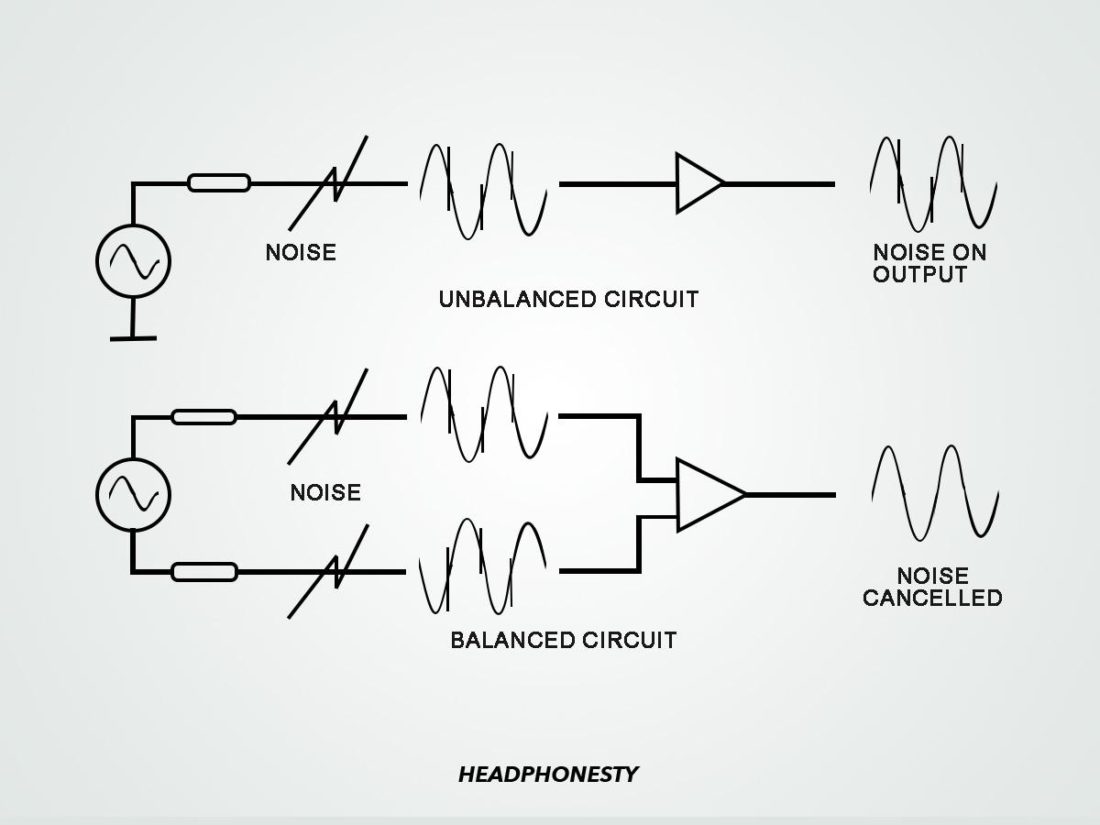
Balanced audio is all about interconnecting audio equipment and transmitting signals in a “balanced” manner. To do that, you need an audio source (amplifier) that can produce balanced output and a cable capable of carrying that balanced output.
A balanced output has two signal phases (or a hot and cold signal) per channel. Each phase has an equal impedance relative to the ground, hence the name “balanced.”
A balanced mono cable typically has at least three conductors (TRS) – two to carry the left and right audio signals to the headphones and one for the ground. In contrast, a balanced stereo cable has at least five conductors (TRRRS) – four to carry both negative (cold) and positive (hot) audio channels and one for the ground.
Advantages of balanced audio
The advantage of balanced connections over unbalanced connections is the canceling of noise interference via Common Mode Rejection (CMR).
Any noise interference that hits the two balanced phases in the cable is imprinted equally on them. The receiving equipment (such as headphones) only cares about the difference between the phases.
So, interference that adds equally to both phases creates no difference between them and is canceled out when the amplifier recombines them. This process of canceling noise while preserving the original sound is known as CMR.
As such, balanced cables can run longer than unbalanced cables and operate in noisier environments because they can cancel out any noise interference.
So when is audio unbalanced?
When the requirements for balanced audio are not met, the audio is considered unbalanced.
For example:
- The audio source cannot produce a balanced output.
- The cable cannot carry a balanced signal (TS, single-ended TRS connectors).
The headphone plug is the key.
With the above two concepts, you should now know that you can send four signal types from the output (amplifier, for example) via a cable to a pair of headphones.
Here’s how audio signals flow with each type of output:
Unbalanced mono
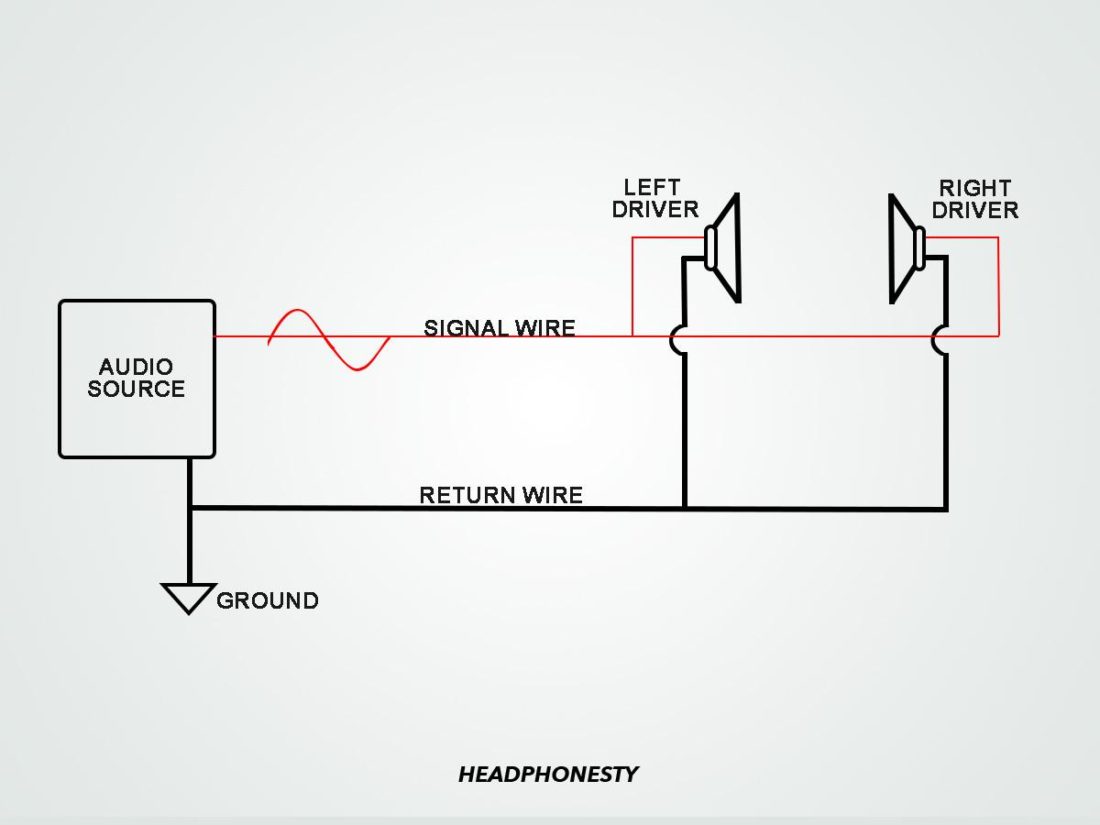
Balanced mono
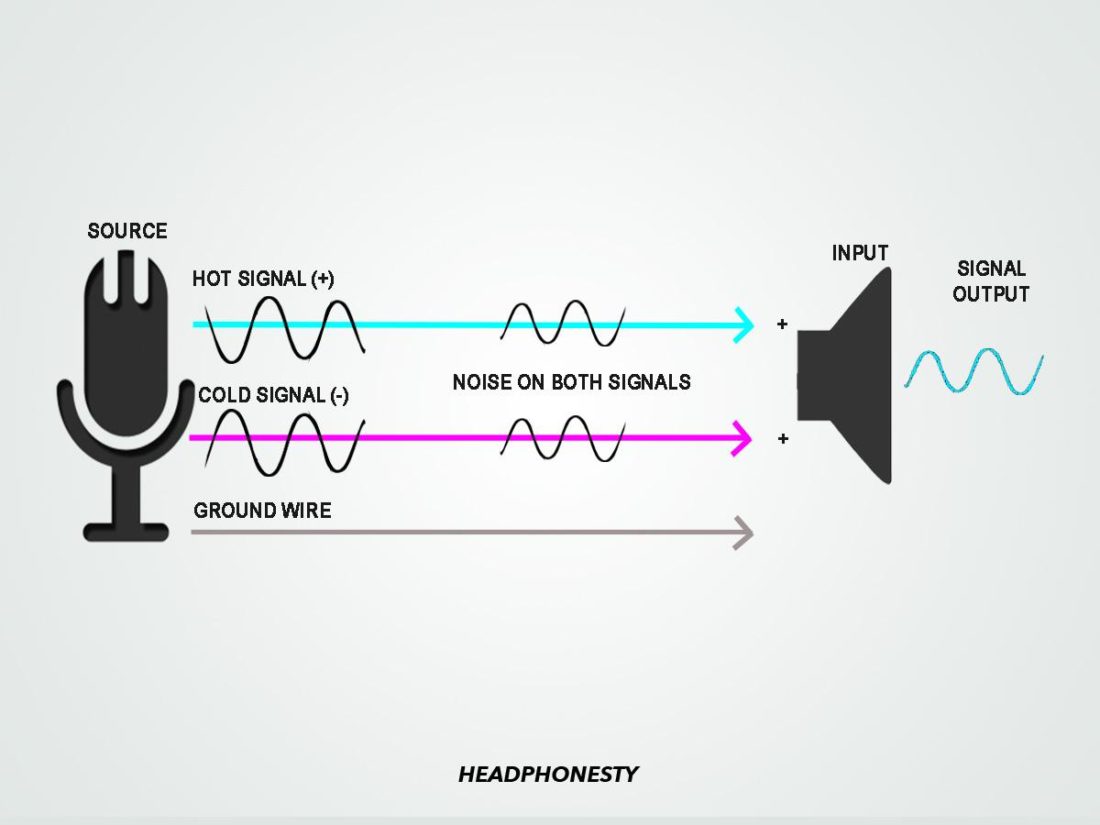
Unbalanced stereo
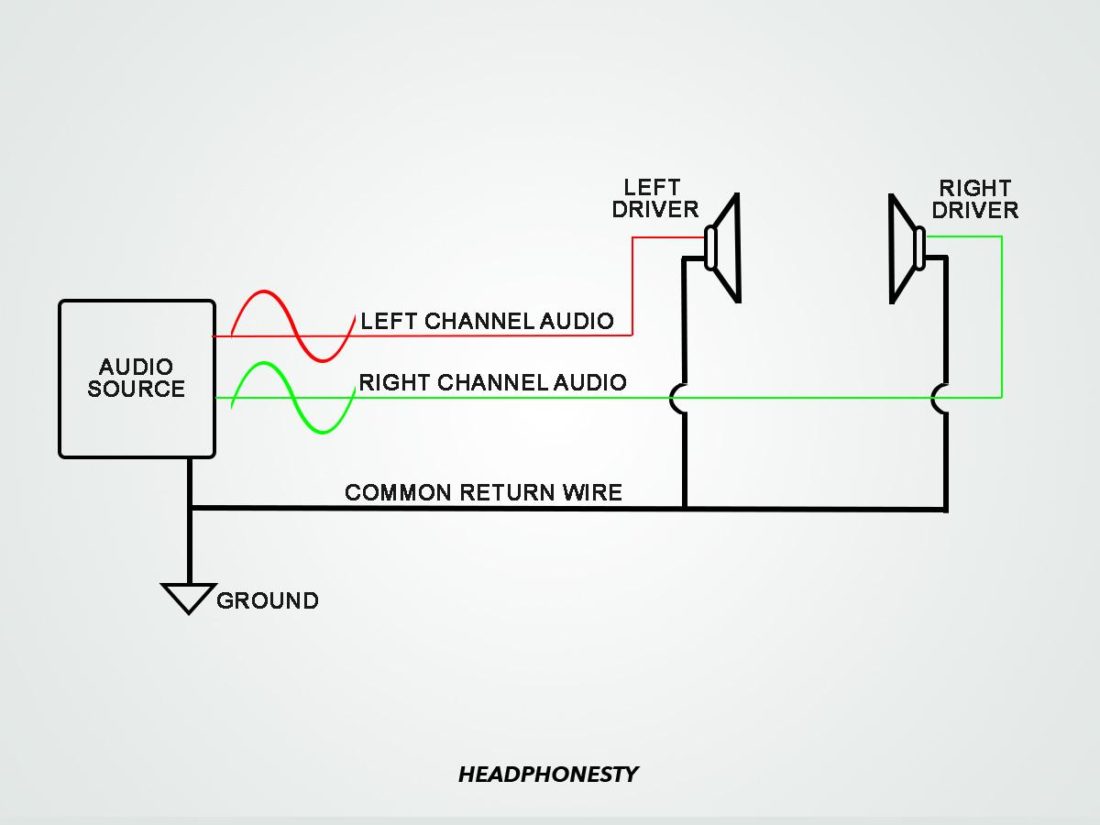
Balanced stereo
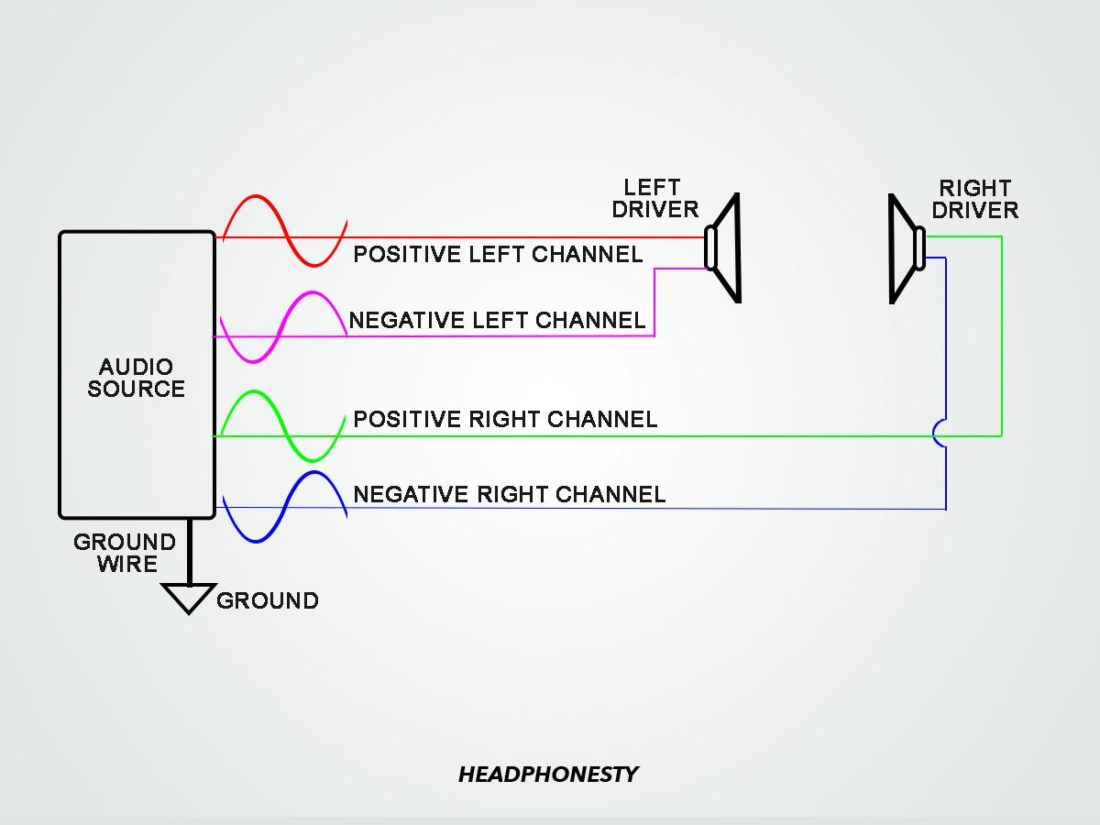
Whether a signal can be fully supported or not depends on the number of conductors on the plug.
That said, here’s a quick chart on what you need to get balanced audio:
| Output Signal | Jack Connector | Balanced Audio Connection |
|---|---|---|
| Balanced Mono | TS | N |
| Balanced Mono | TRS | Y |
| Unbalanced Stereo | TRS | Y |
| Balanced Stereo | TRS | N |
| Balanced Stereo | TRRRS | Y |
Is it confusing?
You’re not alone! The technicalities can be hard to digest when reading all this for the first time. The part about stereo audio using two channels and balanced audio needing two copies of the same signal with reverse polarity tripped me up, too.
An easy way to understand is by first acknowledging the bottom line – that you need conductors to send and carry signals.
The more signals you send, the more conductors you need.
For example, if you want to send a balanced stereo signal, you’ll need:
- one right channel (R+),
- one flipped right channel (R-),
- one left channel audio (L+),
- one flipped left channel audio (L-).
In total, you’ll need four signal wires and one ground wire which only a TRRRS connector can provide.
Thus, if a jack with an inadequate connector is used (like a TRS connector), the headphones won’t receive the complete set of signals to perform CMR. Hence, the entire audio connection becomes unbalanced.
Other Headphone Jacks and Plugs Factors That Affect Sound Quality
As you saw in the previous section, audio issues can occur due to incorrect or incompatible plug configurations. Moreover, these issues can also arise from external causes like dirt or damage.
Here’s a closer look at the other headphone jack and plug factors that affect sound quality:
The headphone jack clamping mechanism
The internal mechanism of the headphone jack includes two clamps designed to push down on either side of the headphone plug.
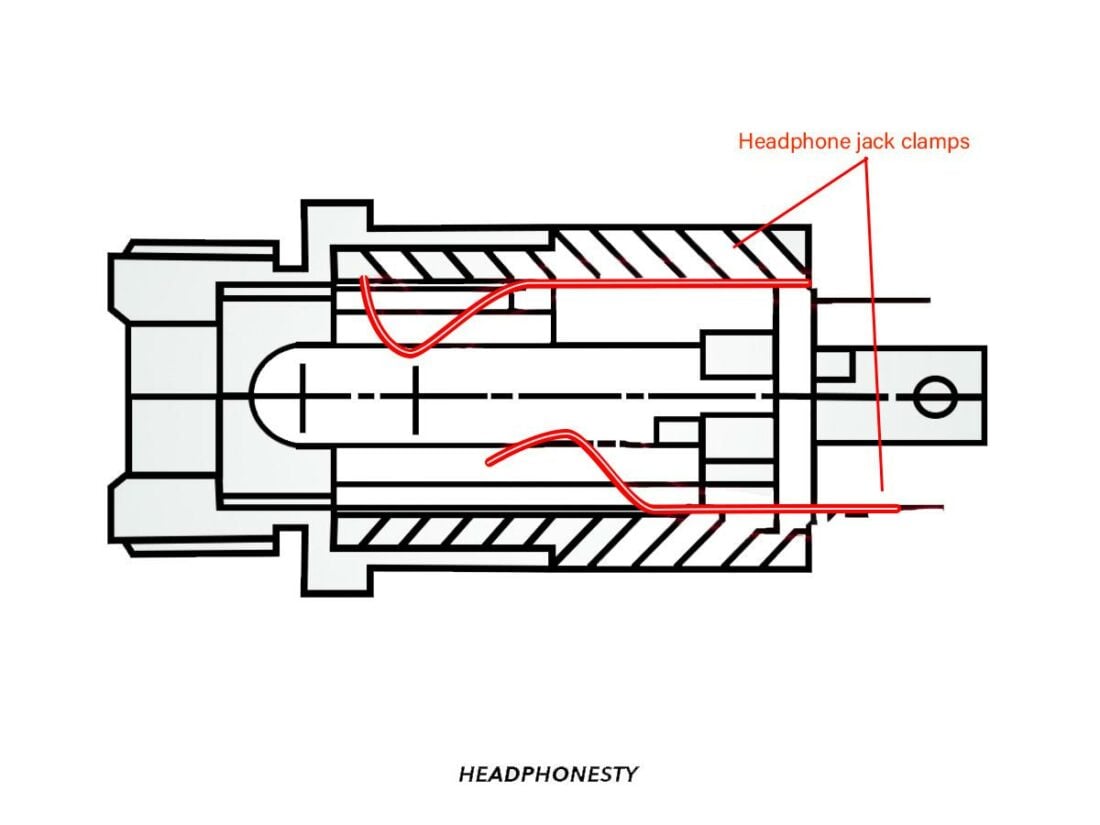
When inserted, these clamps are firm enough to keep the plug steady and centered. This ensures the conductors of the jack and plug are in constant contact. However, they also have a decent amount of springiness that lets you easily insert and pull out the plug.
The simplicity of this design means that these clamps can become loose over time, especially if you’re constantly yanking and reinserting your audio cable. As such, you end up with a loose headphone jack that causes static interference in your audio.
Dirt in the headphone jack and plug
Headphone jacks accumulate dirt over time simply because it’s too easy for dust and lint to enter and get stuck inside the jack. Too much dirt can eventually obstruct the conductors, leading to static noise, muffled sound quality, and other audio issues while using your headphones.
Physical damage
Although made of metal, headphone plugs can still easily bend or break if you accidentally rip them out hard enough. Doing so can result in irreparable damage that will cause audio issues in your headphones.
Essentially, a bent headphone plug means its conductors are out of alignment. As such, you won’t achieve proper contact with the headphone jack conductors. And because the audio signal can’t be transmitted fully, you may only hear sound from one speaker, hear static, or have a low volume.
Let’s Practice Our New Skill
Let’s see if you can put our newfound skills to good use.
Remember the “3 pole plug” term mentioned earlier in the article? What does it mean?
3 Pole Mini
Answer: 3.5mm TRS jack
Stereo Mini
Answer: 3.5mm TRS jack (Bonus Qns: why do we think it is TRS and not TS?)
3.5mm single-ended cable
Answer: 3.5mm TRS jack (Bonus Qns: Is this a balanced cable?)
2.5mm balanced cable
Answer: 2.5mm TRS jack that can carry balanced signals
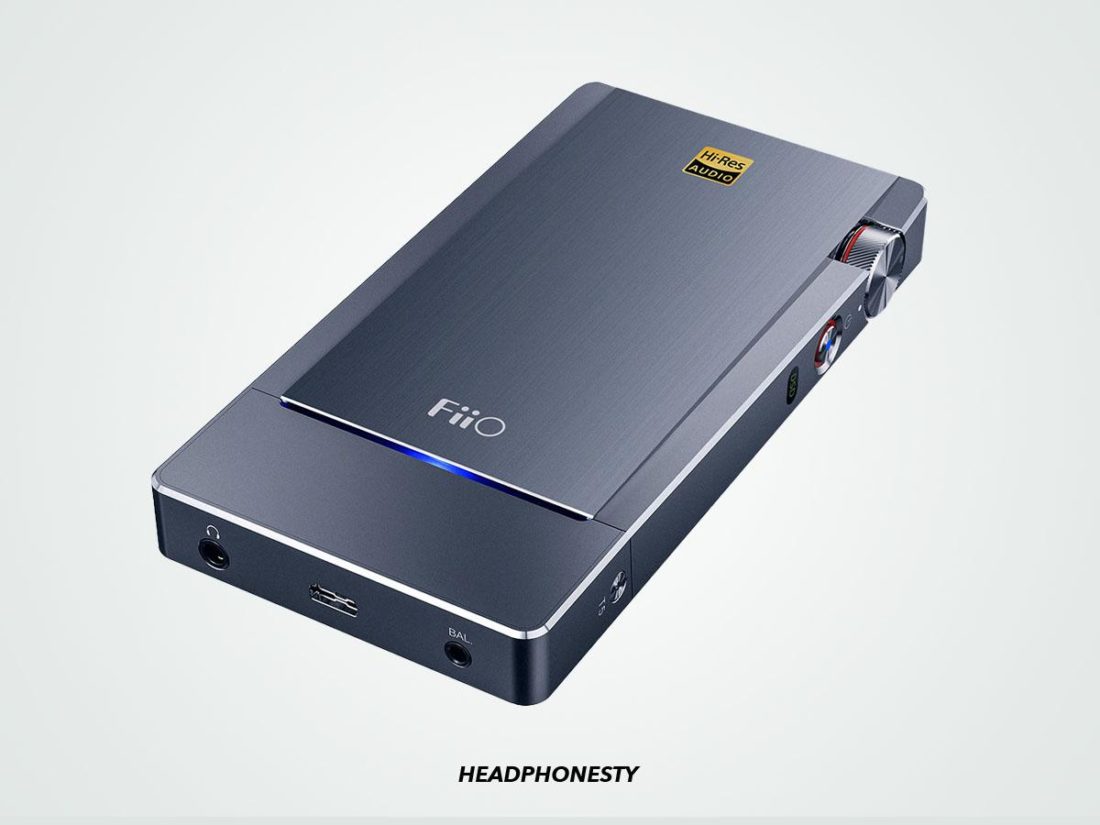
Can you see the two outputs on the FiiO Q5? One with a headphone logo and another with a “BAL” sign. What does that mean?
Lastly, another practice question:
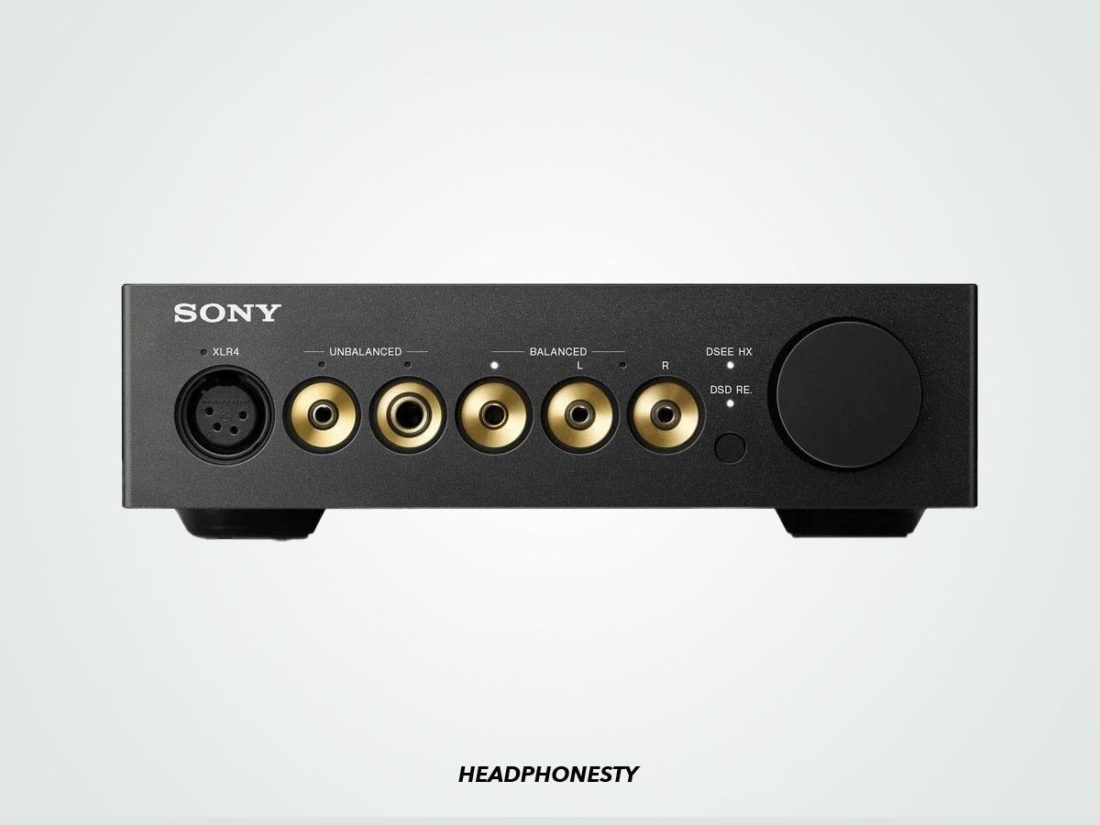
See if you can read the “Headphone Output” specifications of the Sony TA-ZH1ES and understand their meaning.

If you do, congratulations! You just leveled up your audiophile knowledge.
Did you like this article? Did we miss anything? Let us know in the comment section below.
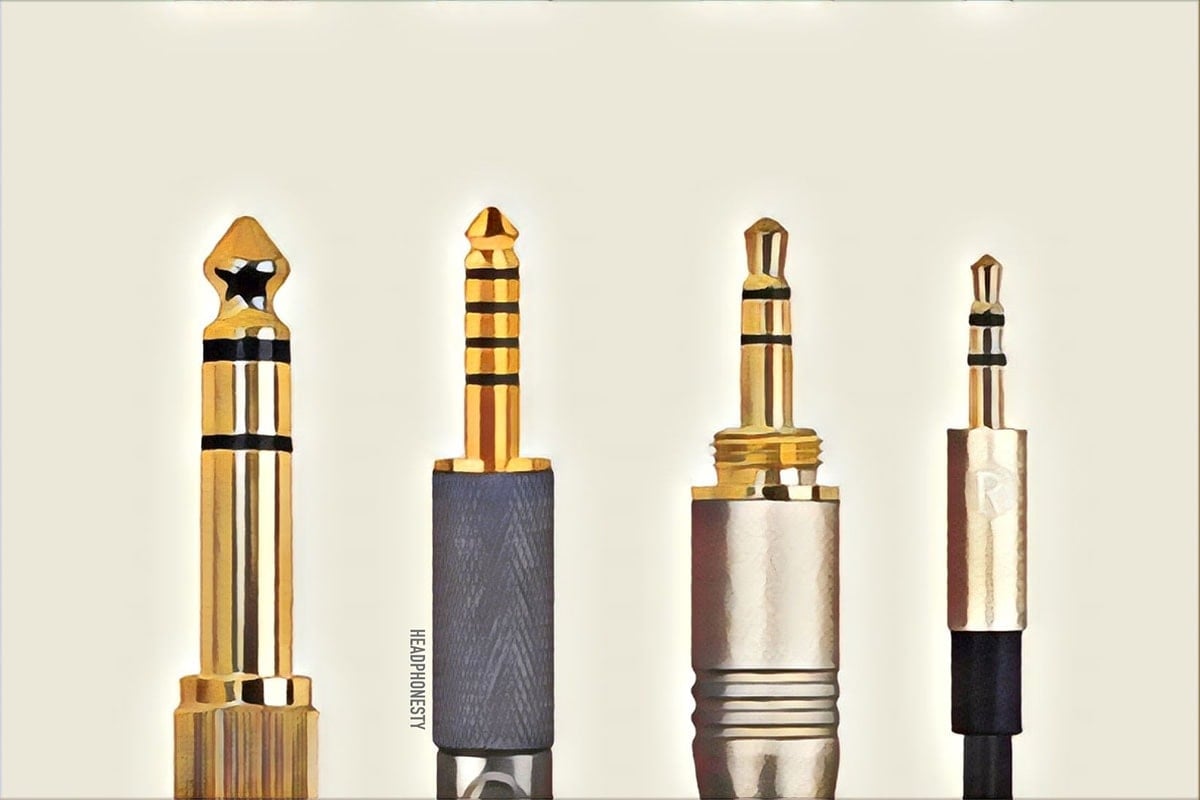
Awesome and informative, rock on!
+1
Couldn’t agree more. Delivers the promise of its headline!
Very useful and exaustive explanation. Get connect!
No one on the web has answered a simple question. Are all Y splitters or adapters internally wired the same. If I have a voice recorder with separate mic headphone jacks can I use any Y splitter to connect a mic headset. Does a red green marked Y splitter differ from a none marked splitter?
short answer is yes but not with a standard y adapter as those are typically built for standard stereo headphones (tip ring sleeve, or left/right and ground), you need to get a specialty y adapter that’s specifically built to separate the mic signal from the mic headphone’s tip male plug and the stereo headphone signal (I’m assuming the headset is stereo not mono) .. so one side of the y cable will have a tip ring sleeve (two black bands) like a standard headphone and the mic side of the y cable will have a tip sleeve (one band) and accept a TRRS plug on the other end.. (as I’m assuming that’s what your stereo mic headset has, as if it had a separate mic cable, you wouldn’t need the adapter.. lol).
so it all really depends on how the mic headset is wired.. if it’s a mono headset or stereo.. also how the adapter is wired and how the recorder is wired.. they can be radically different.. but generally for the most part, they will follow the most typical usage except in rare cases for very specific set ups..
some mic jacks take a tip ring sleeve as well can accept a mono mic signal or stereo mic signal.. but generally, most mics are mono in nature (basically a “stereo” mic literally has two mics inside of one case or side by side)..
it’s all just simple wiring and signal flow… look at the plug tip of the headset.. you can count the black bands separating the different areas on the plug and add one and that’s how many wires are inside the cable (analog only). a jack you plug it into is going to have metal bits only touching those separated sections on the plug tip (that’s why you get the “click”, they are under a little tension to make a good connection and as you push it in, you are lining up those connectors with the appropriate connections in the jack.. which is why they have to match.. a combined mic/headphone jack (common now on laptops and phones) will have four connections.. left. right. mic. and common ground (you can use one ground for all three, as this is due to the nature of a grounding wire and what it does.. too long to explain here). and you can use both regular headphones and a headset with a mic in a combo jack..
it used to be, you’d have a separate wire and plug for the headset mic.. but they started making the combo jack and TRRS tips to save space in the ever miniaturizing world of consumer audio.. and the fact that headsets are used most often with cell phones and laptops.
so, obviously, your recorder doesn’t have a combo jack.. it has a separate headphone and mic input jacks.. and I’m assuming your headset has a three band (four conductor) Tip Ring Ring Sleeve (TRRS) style plug.. as I’m again, assuming the headset is stereo as is typical these days.. (headsets with mics used to be mono and usually just one earpiece speaker (sometimes two earphones but using the exact same signal for both) as people weren’t also using them for music and game audio but simply as strictly a handsfree telephone device and you didn’t really need stereo for just talking.. even early computer headset mics reflected this.. and those would use a 2.5mm jack with a TRS plug and jack.. (tip would be the mono signal, ring would be the mic, and sleeve would be the ground). they used the 2.5mm size to differentiate from regular headphones (walkman headphones as we old timers called them at the time.. and I wore an onion on my belt as was the style at the time.. heh).
but most y splitter adapters still haven’t caught up to the stereo mic headset (TRRS) combo plug and jack.. and a specialty one that splits the headphones from the mic into separate plugs from a TRRS plug are even rarer (but easily found once you know what you are looking for as someone definitely makes one.. a huge market for adapting newer standards to older ones.. but you need the EXACT right adapter that will work for your headset and two jacks on the recorder.. so, see how the two jacks are wired on the recorder and how the combo mic/headphone plug tip is wired in the respective manuals.. (as some mic inputs take a mono or stereo mic signal depending on the device, like a prosumer (not quite industry standard or “pro” and falls in between professional and consumer basically high end audiophile stuff not your average user) portable digital recorder might have..
search for TRRS headset mic splitter for example.. you should be able to use a female TRRS to two TRS male.. but it only depends if it’s wired correctly, there is no standard.. it could be wired as a normal headphone splitter totally ignoring the mic input or it could do what you need it to do.. it would specifically say “separate mic signal from stereo headphones” or something very similar..
basically, you need a trrs female jack to two male jacks with one carrying only headphone and the other carrying the mic signal.. it just saying “2 trs males” isn’t enough to go on honestly. it NEEDS to specifically say it splits the mic signal into it’s own male jack.
hope the helps and informs.. cheers.
Brilliant response.
Very informative article! Thank you.
Thanks Colin for this very helpful article. I understand Hi Res and balanced sound but I use Sennheiser MTW earbuds, BT 5.0. I love their sound and the tuning is superbly balanced but I know that the music will sound better though headphone jack.
Japanese firm Aviot has produced Bluetooth earbuds with two dynamic drivers and one balanced armature. I don’t know what they sound like but know that wired will always have better quality sound for same source.
Can or will Bluetooth technology ever match wired?
Thanks.
Graham
Contrary to what this article says, you should *not* refer to 3.5mm connectors as “1/8 inch.” There was an older size, really 1/8″ diameter, ca. 1960s. Do the math: 1/8″ = 3.175mm.
If you actually have an old 1/8″ plug, it will be very sloppy in a present-day 3.5mm jack. Conversely, if you have an old rig (tape player, etc.) with a 1/8″ jack, a present-day 3.5mm plug will not fit in the hole.
Calling a true 3.5mm connector “1/8 inch” is like calling your size 32 jeans “size 29.” It’s a significant difference, more than ten percent.
(However, 6.35mm really is the same as 1/4 inch. The Japanese did not change the physical size when they started making this connector, which originally had English system dimensions.)
Thanks for clearing up something I’ve wondered about for many years. I wondered why they called it 3.5mm if it was the same as 1/8″. I’m one of those old guys who has been into music since the 50’s, and have seen lots of things change. When they came out with the 3.5mm jack I assumed it was the same as the 1/8″. I just got out a scale and checked several jacks I had. Yep, some were 3.5mm and some were 1/8″. They’re not the same.
Is it because I am in europe and you in america? I’m puzzled.
Here in Europe ”tip” is the Right channel ”ring” is left and sleeve common ground.
Only exception I ever found was on my Samsung television…..
Nice article BTW…
I find it hard to believe that tip is right channel in Europe. That means every manufacturer of audio equipment — TVs, radio receivers, audio mixers, portable radios and CD players, pro audio gear used in every broadcast station, etc. — would need to make one version of equipment for Europe, and one version for the US. Not gonna happen. For that matter, I’ve worked on equipment bought in Europe, then brought back to the states by servicemen or gov’t employees who were stationed overseas. I never ran into tip=right. I’ve never seen schematics of imported (to the US) gear that had a note saying “in Europe headphone channels are reversed.”
Going back 60 years, I’ve had pro audio gear made in the US, in Germany, in Japan, as well as consumer equipment from all those places and more. Tip is always left; ring is always right. This was true with 1/4″ TRS connectors, as well as the newer 3.5mm size. Perhaps you’ve always had your headphones on backwards.
Now as to what has recently changed: many cellphone manufacturers have started using a single connector for stereo earphones *and* mono mic. They’ve added an extra ring (designated R2), moved common ground to that new R2, and then the mic hot wire goes on the sleeve. Tip still is left, ring still is right. Headphones w/ the usual bigger sleeve will usually play back OK. Mics will not work without TRS>>TRRS adapters, and it’s a real pain because I think most consumers have no clue about this, so many seem to think they have broken equipment when things don’t work as hoped.
Hi Greg, sorry for wasting your time,I ‘ll check before I post next time.
I was so convinced I fear I have dementia….
Well, I can repeat; Usefull article!
Can I use a TRRS to TRRS (m-m) from an old boom box to a cellphone jack (to use as a pillow speaker)? Cellphone speakers are so far superior to the flimsy sound coming out of retail pillow speakers, I’m constantly yelling at the mice to keep quiet.
Now that’s what I call informative. I’ll probably have to read it several times (if I go out without a shopping list these days I come back with the wrong stuff) but that’s just me. Excellent, top marks all round.
Great Article! Even the comments teach you things…seriously.
“A pointed tip jack will prevent a rounded tip plug from being inserted fully, …”
That’s an interesting factoid. Where did you dig it up?
Anyone make a 3.5mm TRS male to female? I need it to fool my LG phone into high impedance mode.
Here I am…a 70-year-old fart trying to keep up with he millennial technical age of understanding. My first computer came in 1983, so, I’ve done pretty good; and I find such articles as this one a TREASURE to find…because it was SO well written and explained; however—as the person said earlier—I will probably have to go over it a few times to get it. And I was a professional musician for about 22 years. things have really changed since that career ended.
You didn’t mention headphone bias voltage and polarity. Ideally, an AC signal centered on zero volts is sent to the headphones, maybe via an output transformer to remove any DC bias. If I understand it correctly, unbalanced line level audio is all positve voltage, from +0.2 volts up to +1.8 volts, allowing the next piece of gear to use a single sided amp. Main reason: transistors can only amplify positive voltage. After going through a 1:1 matching transformer you’d get -0.8 to +0.8. Maybe that explains the thump I can sometimes hear on headphones when my macbook audio turns on and off?
what type of adapter that i need to buy if i want to use my earphone with my piano keyboard?
3.5 mm TRS [stereo] to 1/4″ TRS [stereo]
I am using stereo audio codec in my design, I want to know the pinouts of audio jack to connect it.
Can I get the pinouts of audio jack?
Yeah let’s confuse it more with bias voltage! Major nerds here!
Great article for a master of seventeenth century technology like me. I understood a good bit of it I think, Just a question: I saw someone use a splitter meant for a video camera. It has a trrs on one end and 2 trs(s) on the other. He used it to plug an external mic into an iphone. I am confused because my understanding now is that a lot of headphone jacks, especially for phones, are designed to function for a phone headset that has both audio out left and right for your ears, and a mic audio in. So, if I have a stereo feed (from my Zoom H4 line out jack, the Zoom h4 has two mics on it), that would mean I have to use an adapter that has a stereo, trs plug (because I am guessing it is not balanced, but maybe I am wrong) on one side, and a trrs on the other. But the headphone jack would think (I know they don’t actually think, but) it’s designed, rather, to send the stereo signal out to headphones, and only a mono signal in. So what exactly would happen ? Would just one signal from one mic be recognized and no sgnal at all would travel where the stereo out would have been? Which mic would go in to the device, the left or the right? (Good Lord, and I thought playing the violin was hard! I wish recording would be easier, but I don’t get or speak tech.)
The Zoom H4 outputs are
Headphone – 3.5mm unbalanced stereo [TRS]
Line Out -Also 3.5mm unbalanced stereo [TRS]
{it is recommended to use a “Y” adapter 3.5mm TRS to 2 RCA plugs [L/R] for audio equipment.}
USB mini to USB [whatever, usually type ‘A’]
One more thing – phones do use TRRS because one is the mic. This is also, in this case, unbalanced L/R out and unbalanced mic in. An adapter [TRS] is needed when connecting to standard headphones [not all of them] or to audio equipment. This adapter eliminates the mic channel. it is necessary to do this, otherwise the headphone plug will be [might be] connected to Left channel + Mic Channel. This is not optimal, especially because some outputs use a difference signal L to R and that would not be present. So, you might not get anything worth listening to.
Thanks for the article. Well done.
I’m trying to connect my iPhone to my headset via an amplifier. I’ve just ordered a cable, 3.5mm male line out from iPhone to 2.5mm male line in to amplifier. Hope it works when it arrives next month.
I’ve got a 3.5/3.5 direct cable with no amp and that works. Watch this space.
If I make a headphone cable with one end of 3.5mm jack and the other of 4.4mm jack would it be ok?
Probably the best technical pub I’ve ever read …. and I’m a EE who was in the IT business for 40 years. Just outstanding clarity and pics …. Thanks …. what a pleasure to read!
I am trying to find an adapter which will allow me to convert a 2.5 mm diameter X 13 mm long plug into a 2.5 mm diameter X 11 mm long plug.
I have a consumer level 2-way FRS/GMRS radio that has a jack that fits a 2.5mm X 11 mm plug. I am needing to use a different headset due to the extremely noisy environment I am working in and my headset has a 2.5 mm X 13 mm plug. When the plug is inserted in the jack it does not seat firmly since it is 2 mm longer and does not match the measurements. Do you know of an adapter that would solve this issue?
Any help would be greatly appreciated.
Sincerely
Scott
I need this information as I’m building the same type of cross over plug for Motorola Talk-a-bout’s. It seems to be a proprietary jack; Motorola is taking lessons from Ford.
Please pass along any info on buying the longer than normal jack.
It seems that they have used the power plug version of 2.5mm to try to make you buy theirs. If you’re adept at soldering, you could buy a 2.5mm x 11mm power plug and solder it to your current headset.
Thanks for this article. I think it helped me identify an old Radio Shack 2.5 mm headset with mic (HF-2001) that I have as a TRS plug with “Unbalanced Mono” and the additional conductor carries the microphone signal. Does anyone know what adapter I can use to make this work with a standard (recent) 3.5 mm Android smartphone jack? I tried to get a regular 2.5 mm female to 3.5 mm male, but it doesn’t pass the microphone signal through, only the audio.
For anyone else with this issue, I found an adapter that works from Headset Buddy – https://www.headsetbuddy.com/2-5mm-headset-to-3-5mm-male-adapter-for-smartphones/
Help! I have a cordless Panasonic phone with a headphone jack that is smaller than 2.5 mm! I had an adapter that stepped my standard 2.5 mm headset down to this smaller size so I could work from home hands free. The adapter now has a break in it and pops and crackles and is driving me crazy. This article gave me one more piece of info, the adaptor is a 2.5 mm female to a smaller??? TRS male! I can’t figure out the step down size to order a replacement! I’ve guessed 2 mm, 1.5 mm, nothing on Google. The users manual online just says “headphone jack! Useless! It is model KX-TGA931T cordless phone with answering machine base. Why do the Japanese have to make everything smaller/non-standard…sheesh. I’m having flashbacks to that movie “1941” where the Japanese soldier is trying to fit that big American radio down into their submarine! Ha! Anyway, can anybody point me to a link to this adaptor??? Thanks in advance!
In addition: https://www.amazon.com/Sony-SRS-T33-Compact-Portable-Speakers/dp/B0001RM9GA?tag=headphonesty0420-20
Years ago, I bought a Sony Active Speaker System SRS-T33. The “plug” (what must be a 2.5 3-conductor plug with green insulating bands) fits nicely into laptop, but now I would like to find an adapter for this little speaker to connect to my iPhone 7S. Any suggestions? I found this, but am not sure it will work because of the color bands (green on the Sony). I would greatly appreciate your help. https://www.miniinthebox.com/en/p/8pin-to-3-5mm-jack-audio-cable-for-iphone_p7425254.html?prm=2.1.250.0
Here’s a link to the Sony speakers on Amazon. https://www.amazon.com/Sony-SRS-T33-Compact-Portable-Speakers/dp/B0001RM9GA?tag=headphonesty0420-20
I’m looking for 6.35 mm female to 3.5 mm female audio jack adapter. Or could you please tell me how to make this connection work.
Thank you for such a full and helpful article. Love the diagrams and tables. Very clear. Can you use this way of looking to explain how we can get a line in to a Mac laptop or iPhone so it acts as an external mic. Preferably from a a simple TRS output. I imagine there is an adaptor
An excellent article – I am saving it for future reference. But I have the following question and in attempting to find the answer to it I stumbled on your outstanding article and illustrations.
Q: Over the years I have repeatedly found that male/female 3.5mm socket connections develop static and/or actual loss of signal due to the fact that spring tension in the female socket degrades – due to insufficient electrode contact pressure and due to oxidation of contact surfaces; here I’ve used Deoxit with some success – but basically the problem persists and grows.
I believe the primary cause is that the 3.5 mm female dimension is just too darn small to allow for robust physical spring contacts to be employed within the tiny internal spaces available in modern portable electronics, especially given the low voltages involved.
Ergo, I had been Googling for a perhaps slightly OVERSIZED male-female jack ADAPTER, which would stay in place within the radio (semi-permanently) – while the female end would be designed to easily take the daily in-out punishment of the headphone male jack by introducing far more robust spring tension.
No luck so far.
Unfortunately this is a failing of the plug type and why I would never design any product that uses it. it’s just too small and flimsy to hold up. mfgrs know this and they use it anyway so you’ll keep buying new stuff. [IMHO]
It’s also why professional gear uses XLR or at least 1/4″ [6.35mm]!
I am hard of hearing and trying to connect a Sennheiser amplification system via the headphone jack in a Marantz AV receiver. When I plug it in to the,jack on the receiver, the speakers cut out. No way to override. I read on another site that using a 4 conductor jack rather than 3 might make a difference. Any logic in that?
Great effort to dispense all this info, keep it up Colins!
Great article. Thanks
Question: I need to extend audio cable. On the cable from my headphones there is a 4 conductor male plug. The extension cables only have 3 conductor male and female plugs. I only require audio and mic for the extender. Will a 3 conductor extension cable work? Thanks
im looking for a 3.5mm jack to 1.5mm sony jack for original MDR – D77 Eggo headphones. can’t find them anywhere. Please advise
https://imgur.com/OpirNSm
Hi, great in depth article. Can you please help me with a specific problem please? I have a TV on my caravan with very poor sound quality and I have unsuccessfully tried to Bluetooth the sound to a USB-Aux device plugged into my on board radio/cd player which has USB and aux plus large speakers for better sound (8 years old maybe) , unfortunately there is latency and the sound and picture do not sync. My last option is to use an aux cable from the TV which is supplied with a phono/aux link cable. The 3.5mm pin on the link has four poles. Can I use any cable to connect to my radio 3 or 4 poles?
Thanks in anticipation.
Bluetooth has an inherent latency. There are new BT devices with little to no {?} latency.
3 or 4? I’d say try it. Worst case, it doesn’t sound right. best case, it works, but if not, look for a TRRS to TRS [4 to 3 pin] adapter. They’re usually only a couple bucks. since it’s low level audio and headphones are in the 10k ohm range with <2v it should be safe to try it.
Help. I have Fiio M11 and sennheisher 599 I want to use the 4.4 mm output but cannot find a 4.4 male to 6.35 female adapter. I did find one but it was November ship date. I could use double adapter 4.4 to 3.5 and then a 3.5 to 6.35 but that seems like not a good way to go. Any ideas?
wow. FANTASTIC article. i am not an audio person, or musician or really even care about sound and ports and equipment. BUT, this was super informative and easy enough for a noob like me to understand. really a fantastic bit of information that made things clear.
I am looking for a soundbar which can send audio to headphones / earbuds.
If there is not a sound bar is there a way to hook them up. When the earbuds / headphone is in use then the sound on the soundbar should be shut down
Thanx. But, the female jack in my LG Stylo V phone has “loosened” and will not transmit audio to my headphones. The male plug doesn’t fall out. But, it is loose. HELP.
Great article on various jacks but it did not answer my question. Which 3.5 jacks are compatible without damaging equipment? Especially plugs with one or two rings? May one use a plug with two rings (cable has buds and mic) on a device that is intended for headphones only? And the other way around.
The last two lines of one of your tables are:
Balanced Stereo TRS N
Balanced Stereo TRRRS Y
The last one makes perfect sense to me, but I can’t figure the one before it. I don’t understand how one could get balanced stereo with just TRS, and I don’t understand how it can be balanced stereo with “N” in the third column.
Can you elaborate? thanks
Although early in the article it mentions people buying something that ends up not working because the bought the wrong style, it does not mention if there is any interchange ability with the different styles without adaptors.
My background: Mechanic, roofer, carpenter, machine tool builder, I can play the radio.
My project: I have a turntable with a USB cable and audio editing software on my lap top to where I can digitize my album collection. I can also record directly from the lap top. The problem is, when recording from the computer the comes out the speakers and recorded from the microphone. Recording this way means the room has to be quiet during recording and it also adds a slight humming sound. I would like to try plugging into the headphone jack (3.5mm TRS headphones work) to the USB port and see what that does. I have seen both (3.5mm) TRS to USB and TRRS to USB adaptors. I would like to get the latter for more versatility down the road, not to mention they are cheaper, but don’t want to waste money on something that doesn’t work.
Very informative article, thank you for your time.
In the app you can select which sources to record. deselect [computer audio, sounds, etc.]
Audacity is the best app and it’s FREE!
Negative: Audacity has exactly this problem of not offering microphone silent. whatever you _record_ through wires, mike noise always enters. Been like this for years, unsuitable for recording. Otherwise great for editing.
How can I identify if a jack is TRS or TRRS? I replaced the OEM stereo in my Mustang with a Kenwood. The back of the Stereo has an AUX IN that the manual identifies as a TRRS. The dashboard adapter kit provided has interchangeable component pass through connectors (e.g. USB, HDMI, and audio jack). The configuration of the audio jack is not specified. I connected a male-to-make TRS cable to my PC and to the audio pass through and a set of ear buds with a TRS connector to the other side of the pass through. I can hear audio out of the ear buds. Is this sufficient to determine that the pass through is TRS and not TRRS?
Jake
Maybe someone can advise me. I have a new, original, in the box Sennheiser HD 525 Stereo Headphones I purchased some yrs. ago but never used. I now want to use them w/ my desktop PC. I need an adaptor but Sennheiser website is useless. I need to know what type of adaptor I need and where I can get it at the best price. Thanks.
I am having difficulty and was wondering if someone can help me. I have a special headset that I use due to my hearing impairment called HATIS. it is no longer in production but works fine in the office but I need to be able to take calls for my job at home and the only way to do this is by using a USB cable. This end connector of the HATIS headset is a 2.5mm one. We tried a basic USB cable with the 2.5mm jack and it did not work. I did hear a bit of sound out of one side of the headset but the person on the other end could not hear me at all. Is there a solution to this problem?
Help !!! How can I channel my stereo headphones into my one good ear??? What adapters do I need? Pls advise. Regards A.Kay
But why is balanced 2.5m only TRS?? .. as mentioned in the quiz section..
I just bought a SAIMPU Voice Recorder. I already had a SONY headphone with a 4 conductor plug (TRRS) 3. After trying to plug in my headphones today into my new SAIMPU Voice Recorder to listen to music, I realized there was a problem. So, I went and looked at the SAIMPU Voice Recorder Amazon.com advertisement, read the SAIMPU Voice Recorder user manual again, as well as examining the plug on my SONY headphones. I’m not an audiophile and had no idea that there are now many different sizes of headphone jacks and plugs. The Voice Recorder advertisement on Amazon.com said SAIMPU has a “2.5 mm headphone connnector” but the SAIMPU Voice Recorder User Manual says that it has a “3.5 headphone jack”. Are adaptors available to connect my headphone to my recorder? What specific kind of adaptor do I need? Thanks.
Never mind what Amazon says go with the actual size // you will have better odds/luck trying to find a 3.5 adapter if you find one note their return policy it will be a roll of the dice if it works
Great information. Thanks for the clear text. I only wanted to know the polarity of a stereo plug but learned a lot more!
Replacing a 4 pole jack plug on my Sennheiser hd219s headphones. Having trouble working out the inline mic. Have a blue, green and red and gold wires. Then found a red wire which had been wrapped copper like support wires. Can anyone advise which wire goes what connection point on the jack.
Awesome. You’re a geek.
Is the TRS vs TRRS vs etc distinction only on the male side?
I have something really weird that looks like it goes in the headphone jack but the sound doesn’t come out of it also isn’t a microphone either. I think it comes from Aspera. And I have googled a lot! so please help and tell me what it is and what it does
I have an Apple Shuffle (the tiny 1 inch x 1 inch x ⅛ inch) music player that needs earphones in order to hear the music. It is working fine plugged into a small round BUMP APS02F speaker that has a small male plug with two black lines around it. I have some good Sennheiser on-ear earphones with a small male plug but it has two red lines around it. I tested by plugging that into my BUMP speaker and no sound comes out. What is the significance of the coloured lines, and what kind of adapter do I need to go from the Shuffle to my Sennheiser earphones please? Thanks.
3,5mm 3 pole. when plugged in the left and right channels are bridged (short cct). Not shortened to ground. (The cable has no short cct). How can I make sure sockets / jacks are built to correct dimensions?
I found similar on 6.3mm except right channel contact sits on insulator ring. Again, how ascertain parts delivered are of correct function / dimension.
3 wire only, my design does not need switching jack.
Using a pair of Sennheiser HD 820’s what will be the noticeable advantage of using XLR Balanced connectors??? Just curious.
I need some help buying a volume booster/amplifier that works with a headphone with an integrated microphone (TRRS) plug. Sometimes on Zoom, I need more volume. I have a Plantronic/Poly headphone I’ve tried several amplifiers but the other people on Zoom tell me the microphone’s sound is distorted and muffled.
Is there any device/hardware that I could use?
Thanks for your help.
What is the best way to combine stereo output into a single mono input. I am curious for both balanced stereo combined into unbalanced mono and also unbalanced stereo line level signal to unbal mono.
Can bal stereo to unbal mono be done without a transformer? Perhaps if we could load down the signal return with resistance on one channel and load down the opposite side with resistance out of phase and combining the output of the one channel with the return of the other channel. The combined in phase component of both channels should additionally raise the amplitude enough to overcome the attenuation from signal loss due to impedance mismatch? Could it be that simple? Obviously the simple immediate thought to acheive a mono signal from stereo signal is to just splice the two together, but I am afraid that it cant be good to have signal of one channel possibly backfeed into 5the output of th second channel. but if you can load or pull the signal above zero potential it night work?